ENVIRONMENTAL PROTECTION COMMITTEE MINUTES - APRIL 13, 2016
MICHAEL E. PLOCHOCKI, CHAIRMAN
MEMBERS PRESENT: Mrs. Tassone, Dr. Chase, Mr. Burtis, Mrs. Rapp
ALSO ATTENDING: Chairman McMahon, Mrs. Ervin and see attached list
Chair Plochocki called the meeting to order at 9:05 A.M. A motion was made by Mrs. Rapp, seconded by Dr. Chase, to waive the reading of the proceedings from the previous committee minutes. MOTION CARRIED. A motion was made by Mrs. Rapp, seconded by Dr. Chase, to approve the minutes of the proceedings of the previous committee. MOTION CARRIED.
1. OFFICE OF ENVIRONMENT: Travis Glazier, Director
a. Memorializing County Commitment to Keep all Current County Parks-Owned Property Along the Shores of Onondaga Lake Open and Accessible as well as Calling on Other Lakeshore Owning Parties to Provide Permanent Easements for Public Access
Mr. Glazier:
-
Resolution preserves all County owned property around Onondaga Lake in public domain in perpetuity and asks other lakeshore property owning partners to provide permanent public easement to the lake
-
Past studies produced two clear statements - lakeshore should remain open and within public domain and Loop the Lake pedestrian trail should be completed
-
Clarifies County’s intentions for the term “development” – meaning public access, not private development
-
Referenced Onondaga Lake Partnership 2020 Final Vision Report:
-
Reconnecting to Onondaga Lake means - accessibility, retain public control and access to the lake”
-
Public ownership and access to the lake is one of the most often repeated goals – “The future of the lake should be about public access”
-
Many participants cited the need to complete the Loop the Lake trail system— “The trail should be usable for biking and hiking, provide access to view wildlife, go fishing, or launch a boat. In addition, the trail should connect with the Onondaga Creek Walk and the Erie Canal trails”
-
Referenced FOCUS Onondaga Lake 2012 Report:
-
Common suggestion to complete the Loop-the-Lake trail, to connect to downtown Syracuse and to connect with other area bike trails
- Development: “Preservation of public access to the lake and shoreline is paramount”
-
Theme and public opinion have remained constant, legislative resolution history also shows intent for increased public access and maintaining parks property within public domain
-
Resolution calls on property owner partners to provide permanent public easement for pedestrian trail or general public access and asks NYS DOT to examine pedestrian friendly measures for Route 370
-
Murphy’s Island memorializing resolution affirmed County’s intent to keep parks property within eminent domain
-
1980 Legislature passed Resolution No. 242 – enabled County Executive to purchase Murphy’s Island for $50,000, resolution stated the premises were needed for parks and recreation
-
Notwithstanding 2011 Resolution requesting County consider turning over Murphy’s Island to the Onondaga Nation and remove eminent domain, the County had a constant effort to increase and maintain public access around Onondaga Lake
-
Legislative action since 2011:
- February 7, 2012 – Resolution No. 12 funded FOCUS Study
- November 9, 2012 – Bond Resolution included Nine Mile Creek bridge funding, extended Western shore trail from the loop to its current terminus
- May 7, 2013 – Resolution No. 68 authorized the creation of a Haudenosaunee Historical Museum and named such facility the Skä•noñh-Great Law of Peace Center
- November 3, 2014 - A series of resolutions enabled construction of the Lakeview Amphitheater
- August 21, 2015 - Chairman McMahon jumped into Onondaga Lake and August 22, 2015 other legislative members did the same
- August 24, 2015 - Lakeview Amphitheater completed
- September 3, 2015 - Maranda Lambert concert held at amphitheater
- All items are encapsulated into single resolution - time to consider Onondaga Lake as one holistic resource
In answer to Dr. Chase, Mr. Glazier said that other property owners where considered county partners. Honeywell owns the property referred to as the Causeway. NYS DOT and NYS Agriculture and Markets currently own property around or adjacent to the lakeshore, and DEC was in the process of taking over the DOT property – Visitor’s Center and boat launch. Dr. Chase asked if they were talking about only allowing these partners access to build hotels, restaurants and shops around the lake. Mr. Glazier said that he was saying the complete opposite - all Onondaga County Park’s property would remain in the public domain in perpetuity. The resolution states there will be no development. There are different interpretations to the concept of development, public access being one of them. Whereas, the private sector and the potential restricting of use is much different. The resolution unequivocally states that the County intends to keep all of its property accessible to all. In addition, it requests partners to provide permanent public easement so that there is access to all for the entire shoreline of Onondaga Lake. In answer to Mr. Burtis, Mr. Glazier confirmed that these were the only partners and Murphy’s Island was County property.
Mrs. Rapp asked how Honeywell felt about this. Mr. Glazier said that permanent public easement was necessary in order to have a trail from where the bridge lands to the current terminus. Honeywell has verbally committed to providing the access and they are currently building a bridge from Harbor Brook, which will land onto Roth Steel.
Mrs. Rapp asked if there was additional property beyond the bridge location. Mr. Glazier said that Honeywell’s property goes from Atlas Fence to the other side of the Visitor’s Center. In answer to Mrs. Rapp, Mr. Glazier confirmed that Honeywell did not have any objections to allowing public access. Mrs. Tassone said that Honeywell was contributing to the building of the Loop the Lake trail. Mr. Glazier said that Honeywell would physically build the trail. The County has been working the DEC and the EPA in regards to the remedy for those sites; trail build out contingent upon remedy but was the long-term plan.
In answer to Mrs. Rapp, Mr. Glazier said that the 2011 resolution called for turning over Murphy’s Island to the Onondaga Nation and based on statements from the Nation’s counsel the intent was to receive ownership and to have it recognized as territory. Mrs. Rapp said that the 2011 resolution memorialized a consideration, not an action. Mr. Glazier said that the current memorializing resolution was an expression of intent to keep in perpetuity all county parks property in public domain. Mrs. Rapp asked if there was an intention to have some type of presence from the Onondagas or influence over the Murphy Island portion. Mr. Glazier said that no intent was expressed in the resolution.
Chair Plochocki said that he views the Onondagas as a stakeholder in the lake and wants to see the County Executive begin a discussion with them about some sort of long-term presence on the lake - whether it be Murphy’s Island or another location. Mrs. Rapp said that the Skä•noñh Center was a huge presence. Chair Plochocki said that the County owned the center but one of the things that they could talk about was what the future for the center’s ownership should be. The Onondagas having a presence on the lake would not contradict this resolution, as long as there is public access to the entire shoreline of the lake. Mrs. Rapp said that it was her understanding that a territory was mutually exclusive. Chair Plochocki said that he did not see the goals as being incompatible in a future situation where the Onondagas have a presence near or at the shore, without restricted public access.
Chair Plochocki stated for the record, “I very much want to see a future where that does happen and I do not see these goals in the long-term as being incompatible”. Dr. Chase questioned why they would wait long-term instead of adding wording to the current resolution. Chair Plochocki said that they could discussion it.
Dr. Chase said that in 2011 the Legislature had intensions of giving Murphy’s Island to the Onondagas. Five years later, it was being turned around. The resolution needs to be specific, as interpretation gets everyone in trouble. The Nation’s interests need to be added before acting on the resolution. Down the line, other things will come up and making it clear now would avoid problems for future legislators. Mr. Glazier asked if the intent was to restrict use or access at any point. The current resolution clarifies that there is no intent to restrict use in the future. There could be other proposed uses but the resolution makes a clear statement that Onondaga County has had, and would continue to have, a commitment to increased public access for utilization of its property to all. Short of an anomalous resolution, the history of actions for Onondaga County has clearly been increased public access and opportunities on a clean Onondaga Lake. The property was purchased in 1980 for that intent and has remained within public domain. This was not a small action for a then sitting legislature. An anomalous resolution restricted use, now they have a resolution that clearly states the intent of the County to maintain access to all
Dr. Chase said that they could work with the Nation to specify property as their land with public access. Mr. Glazier said that the former resolution called for turning over property ownership to the Nation. The Nation’s counsel made it clear that they intended to have the land recognized as Nation territory and the County’s counsel has suggested that they would not be able to enforce public access agreements.
Mrs. Ervin said that she was saddened that they were not considering the 2011 resolution today. That resolutions intent was clear and needs to be discussed in whatever they do now. Reworking the current resolution was important because five to ten years from now legislators would not know their full intension and it would be something very different. Just like when they discussed Cortland’s ash for trash. Something should have been done about that by now but without the resolution those steps have not happened. Though not apples to apples, this is a comparable situation. They should not consider the current resolution without adding something that protects the rights of the Nation. Mr. Glazier said that there had not been any follow-up since the 2011 resolution – no funds allocated, no home rule request, no further action over the past five years. As noted, a series of substantive legislative actions funded access and research to increase access and change the dynamics of the shores of Onondaga Lake since 2011. Post 2011, legislative history has been clear on its intent to increase public access to all. That is what the current resolution seeks to state and why it was structured in the way that it is. Mrs. Ervin reiterated that she did not want to see the resolution pass as is.
Mr. Burtis said that it falls on legislators to bring an item back, if they have a conviction to do so. The current resolution was a good first step and he does not believe that working with the Onondagas would be easy. The intent is public access to a clean lake. To get ahead of this, they have talked to the current partners and the current resolution was fair and reasonable. He questioned how long it would take for fellow legislators, to work something out with the Onondagas, to add language to the resolution. He does not believe that it would be easy and nothing will be in front of them until that was resolved. Dr. Chase said that since 2011, people have been aware of the issue and nothing has been done to change it.
Dr. Chase said that Onondaga County is a member of the Onondaga Lake Watershed Partnership and one of their guiding principles is to establish land for the Onondaga Nation at Onondaga Lake. She then asked if the resolution was discussed with the Partnership. Mr. Glazier said that they received a letter, and it has been made clear that the Onondaga Lake Watershed Partnership does not speak on behalf of the County. There are many interested parties along the Partnership table and their core is to be a clearinghouse for neutral information. From an advocacy standpoint, the County has an interest, as do many of the parties around the table. They are not always in perfect alignment but it does not keep the County from participating because there is value in having all parties around the table.
Mr. Glazier asked Dr. Chase if she believes that there is future intent for restricted use or access around Onondaga Lake for all - the only question at hand. For 84 years, people have called upon maintaining public access for all to enjoy the natural resource, which has been denied. Keep in mind that Murphy’s Island is located in the City of Syracuse. Currently the only shoreline publically accessible within the City is at the end of the Creekwalk, about 100 feet. Having a Loop the Lake trail along that shoreline increases public access more than tenfold and provides an opportunity for City residents to have a City Onondaga Lake shoreline.
Dr. Chase said that she did not have a problem with access but was concerned about future interpretation. Mr. Glazier said that there was not much to interpret. The resolution simply states that property will remain publically accessible to all and remain in eminent domain in perpetuity. Parks property would not be turned over to any private entity or alienated. Dr. Chase said, “Exactly”.
Mrs. Rapp said that there was much indecision about the Murphy’s Island resolution because they would be alienating public property by giving it to a private entity and they wondered how it would play out down the road. Mr. Glazier said that the resolution did not state that land would maintain in public access. Mrs. Rapp said that she was concerned about keeping the shoreline open for all and that was the reason she voted against the resolution.
Mr. Glazier reiterated that the only question was would they take an action that would restrict access. Dr. Chase said no but they need to work with the Onondagas in good faith because of the past proposal. All of a sudden, the Onondagas are being left out of the loop and she feels that they could work with them to maintain public access but are not attempting to do so with the current resolution. To be fair to everyone, they should reach out and see if this could be done.
Chairman McMahon addressed Dr. Chase’s concerns saying that there would be conversations about potential lake access to the Onondagas for other property that may be more appropriate from a historical significance. He does not view the resolution as punitive. It was consistent with the investment that the County and others have made to the lake, including recent additions and the potential Roth Steel site. OCIDA stepped in to try to ensure that there was not a junkyard on the shores of Onondaga Lake, which was as substantial investment. To keep the consistency going forward he does not think all parties are too far off from the goals. As the plans continue for public access around the lake, there will be greater opportunities to incorporate some of the goals that the Onondagas and others have. He does not believe that the 2011 legislature then had the knowledge of what the Loop the Lake trail and lake clean up would mean going forward. The current resolution should be viewed as an opportunity to continue the current policy.
Chair Plochocki said the Ms. Ervin’s words weighed on him and gave him pause. However, he was going to take a vote but does not see this as being mutually exclusive. There could be suggestions about language changes as there is still time for much talk prior to session. Mrs. Rapp clarified that they would be voting to affirm that Onondaga Lake should be forever open to the public at all points. What they worked out with the Onondagas would be something going forward. Chair Plochocki agreed.
A motion was made by Mrs. Rapp, seconded by Mrs. Tassone, to approve this item. Ayes: 4 (Rapp, Tassone, Burtis, Plochocki); Abstained: 1(Chase). MOTION CARRIED.
2. WATER ENVIRONMENT PROTECTION: Tom Rhoads, P.E., Commissioner
a. A Resolution Calling a Public Hearing in Connection with Proposed Improvements for the Onondaga County Sanitary District ($18,150,000)
Mr. Rhoads:
- Public hearing resolution for West Side pump station project
- Located near Honeywell Visitor’s Center, over 40 years old, reaching end of life
- Much going on around it, e.g. Loop the Lake Trail, access to NYS Fair
- Often unable to handle capacity, needs updating to meet service expectations and add odor control
- Reviewed map (see below) of immense pump station service area – second largest station
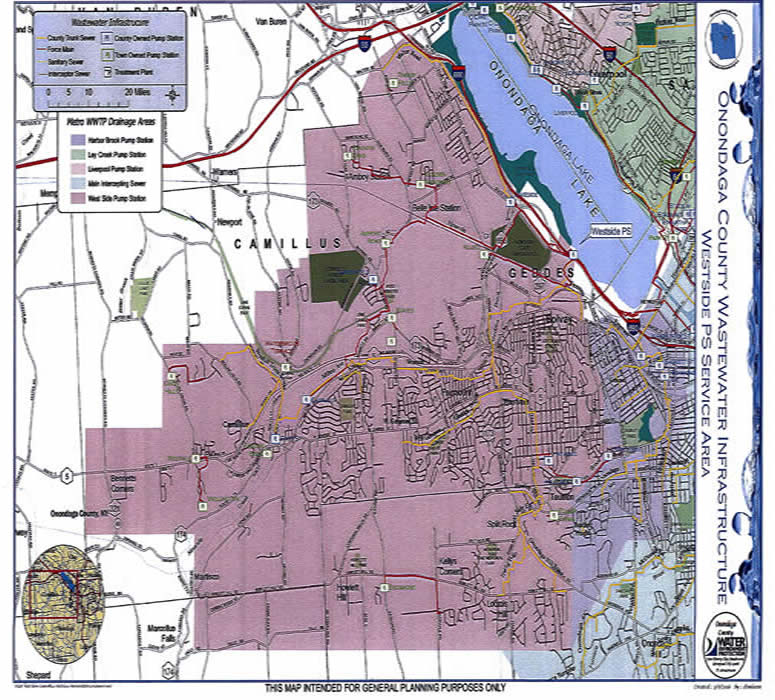
- Update necessary to reduce wet weather overflows
In answer to Mrs. Rapp, Mr. Rhoads said that the building would not be larger but would be better looking, with odor control and emergency generators. Due to extraneous flow issues, all six pumps will increase from 77 horsepower to 150. Just one 77 horsepower pump was able to handle the flow during dry weather. In answer to Mrs. Rapp, Mr. Rhoads confirmed that the increased horsepower was needed, adding that this was the dimensions of extraneous flow. Mrs. Rapp asked if there were also leaking pipes. Mr. Rhoads said that issues with the pipes coming out of the pump station must be addressed in order to move over 40 million gallons per day during wet weather events. Mrs. Rapp asked if this was going into the lake. Mr. Rhoads said that the current station capacity was about 30 million gallons per day, which they exceed at times with all pumps running. The increased horsepower will provide slightly over 40 million gallons of capacity. Mr. Burtis said that the backup states, “Reduces or eliminates raw sewage overflows to Onondaga Lake during wet weather.”
Mrs. Rapp asked if they added a pipe from Baldwinsville down to the sewershed. Mr. Rhoads said that the project was part of their longer vision – diverting a portion of North West service area, parts of Geddes and Van Buren around I-90 and I-690 to West Side and on to Metro. There are concerns about capacity at the Baldwinsville treatment plant.
Mrs. Tassone asked how long they have been looking at the project and questioned the increase from the original amount of $15 million. Mr. Capozza said that the project had been on the Capital Plan since 2002. Mr. Rhoads said that the engineering and project was conceptual at that time. Current costs based on 25% design and the usual allowable contingency are $18,150,000. Mrs. Tassone said that the cost could increase. Mrs. Rapp said the amounts are not to exceed numbers. Mr. Rhoads said that they would have to return to the legislature for approval of any increase.
In answer to Mr. Burtis, Mr. Rhoads said that they believe hydrogen sulfide issues contribute to some of the odor complaints. A six-mile force main in the Village of Camillus carries wastewater to the West Side pump station, which takes about two days and usually becomes septic. Bacteria begins to digest sewage and anaerobically causes the hydrogen sulfides. Hydrogen sulfides creates the rotten egg smell and sulfuric acid when combined with water, which is an aggressive environment for all mechanical systems inside of the plant. At some point they would likely be back to talk about the force main condition.
Mrs. Rapp asked how the project would affect the sewer rate. Mr. Rhoads said that he would bring the debt service range of values to the next meeting.
A motion was made by Mrs. Rapp, seconded by Mr. Burtis, to approve this item. Passed unanimously; MOTION CARRIED.
b. INFORMATIONAL – Asset Management Update
- Introduced Jim Thayer – responsible for asset management, new to team
- Consensus Report recommended infrastructure asset management for wastewater treatment
Mr. Thayer presented the following:
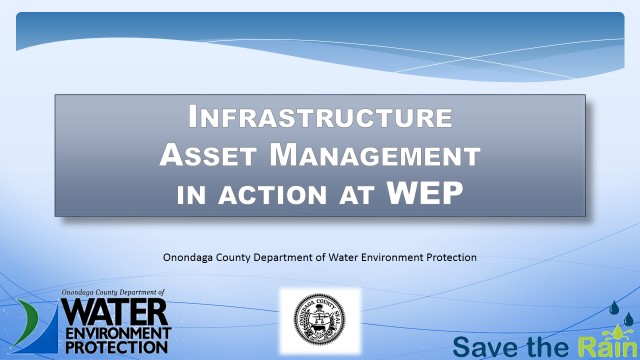
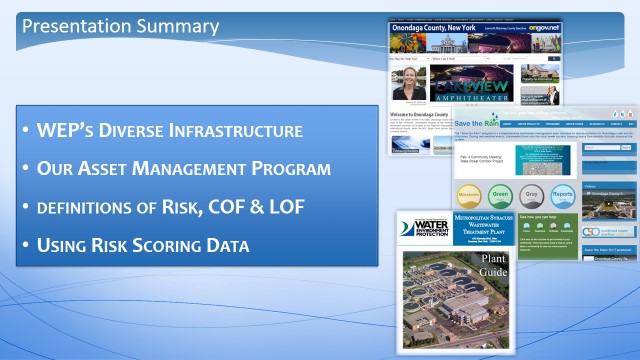
- COF – consequent of failure, LOF – likelihood of failure, both used for planning
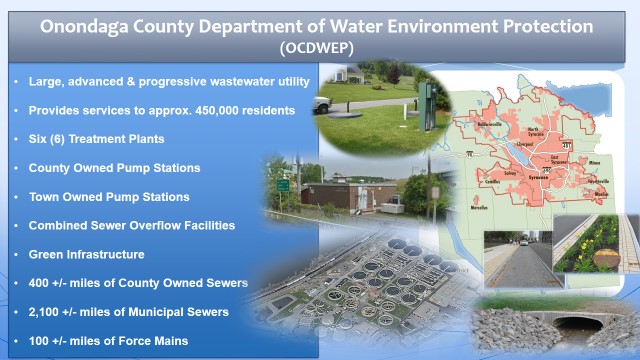
- Over 150 pumpstations and over 2,500 miles of below ground rarely seen infrastructure
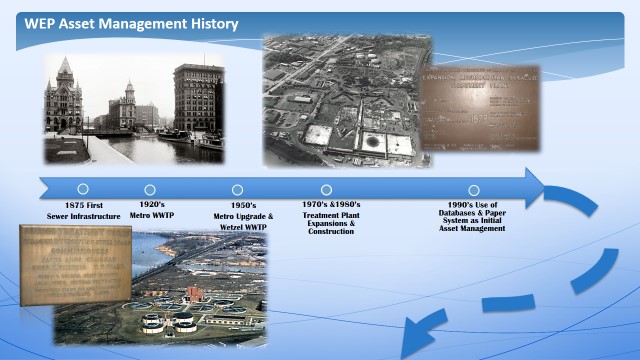
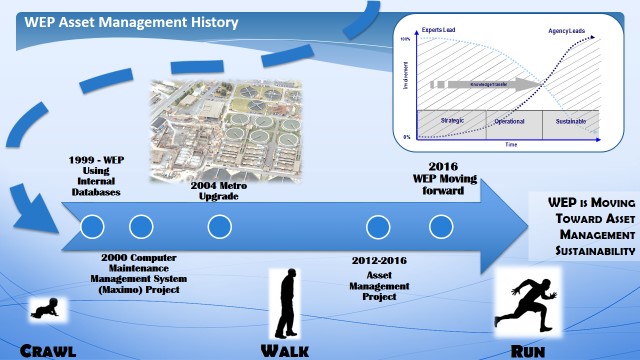
- International Infrastructure Management Manual first published in 2000; Maximo project being further developed to understand condition of assets
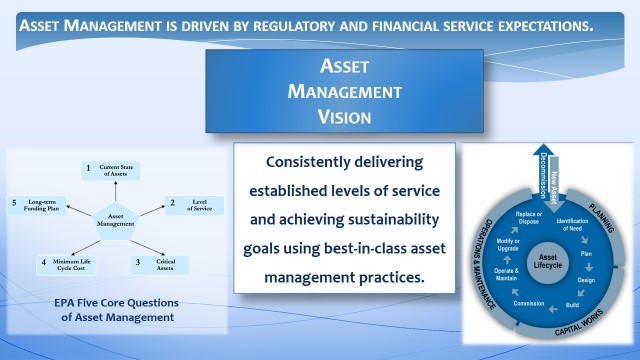
-
Asset Management is a process for planning and tracking the lifecycle of their assets, EPA core questions used as guidance; graph on bottom right shows typical asset lifecycle – constant process, once asset is decommissioned process starts over
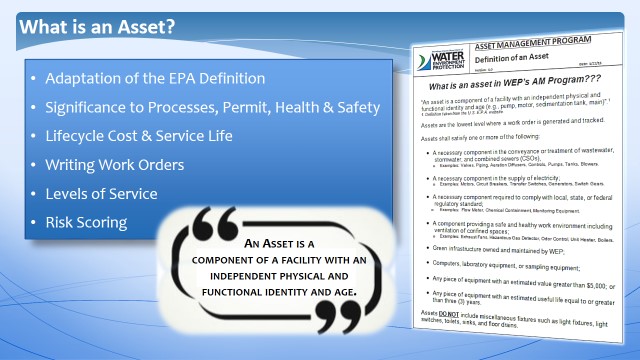
- Track assets to better understand the costs of providing service level
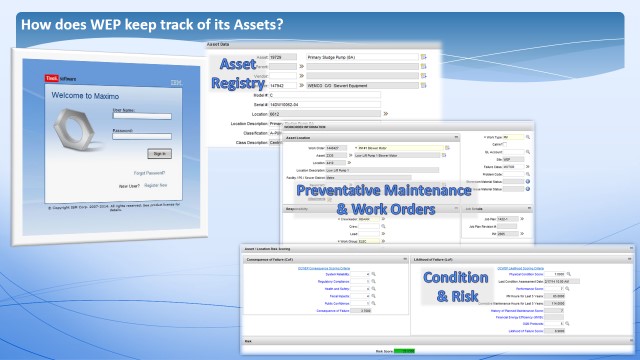
-
Maximo program used for tracking assets, owned by IBM, many functions - use some more than others; knowing current state of asset is an evolving process, constantly trying to improve information and ensure all assets are listed
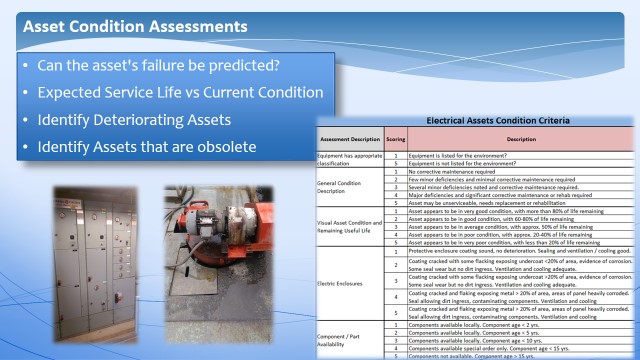
-
Different expected service life for each asset – from 10 to 100 years, looks at when an in-depth study of an asset needs to be completed; categorize assets into different groups, e.g. electrical, mechanical
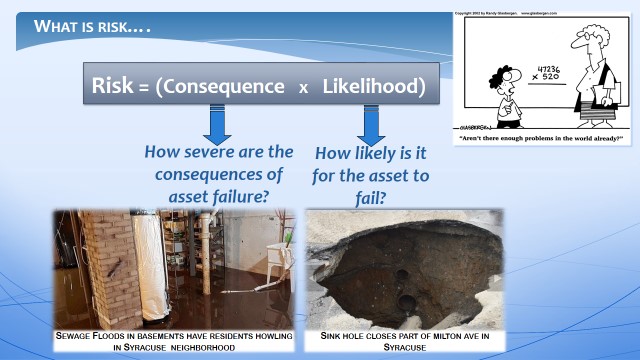
- Large portion of management is risk - much complexity makes up both consequence and likelihood
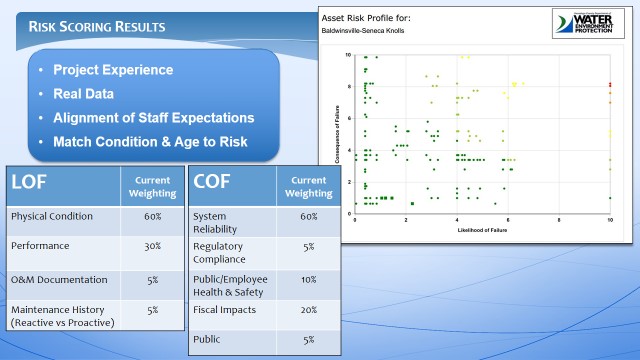
-
Failures happen, try to predict or prevent them; want to keep dots out of right hand quarter of graph – each dot represents an asset, graph completed for part of the Baldwinsville Seneca Knolls project - where they have planned future investments, identified assets close to or failing or failing, needed to be addressed; used to better align scoring and risk matrix with expectations to meet established service levels
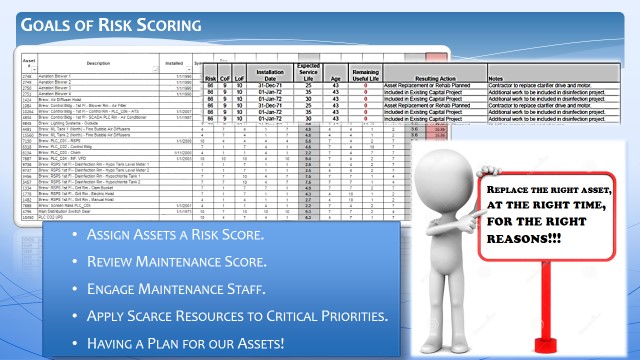
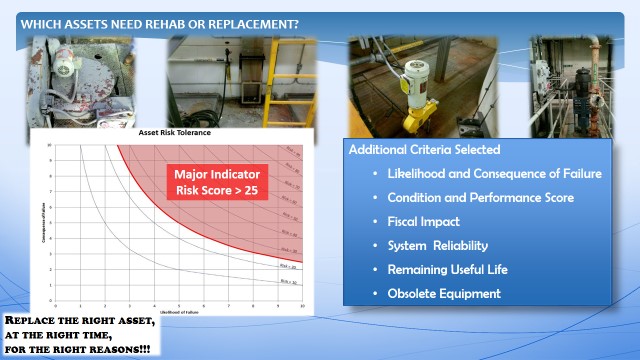
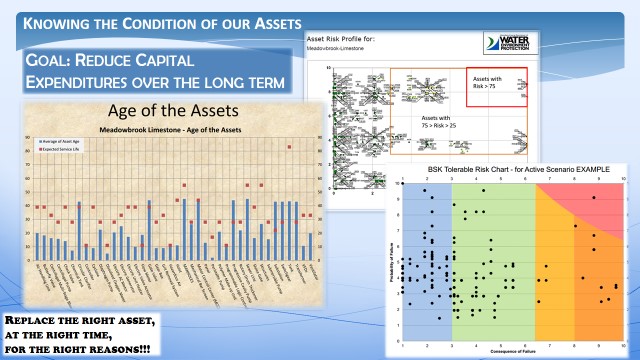
-
Results of other graphs completed showing different facilities, where their assets are and the age, results used to compare against expected life; oil and gas industry asset management has shown over a long period of time management reduces capital expenditure - maintaining equipment to lifecycle cost as much as possible
Mr. Rhoads said that the goal was to ensure that they maintain critical assets in such a way that they can prolong the useful life and avoid frequent replacement bonding requests. They would still need to replace equipment but would use this tool to allocate maintenance resources towards the most critical items, along with using maintenance to extend the useful life, to keep their rate down.
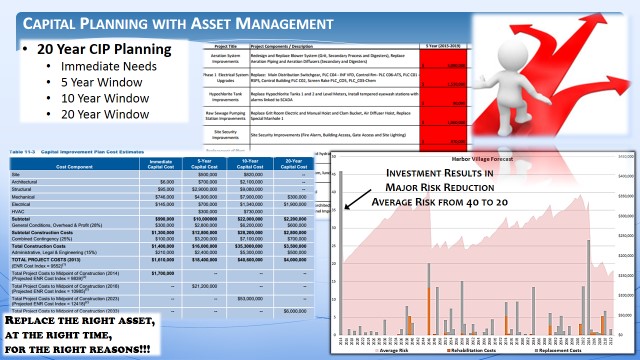
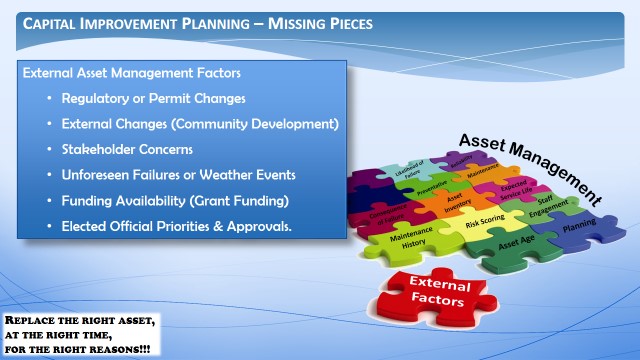
-
External factors could lead to needed capital investment that could ultimately change planning – projects may have to be delayed because of limited funding, must take into account everyone’s priorities and concerns to replace the right asset at the right time, for the right reason
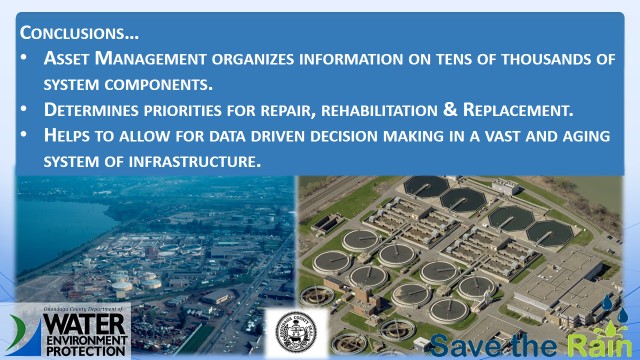
- Organized information provides good knowledge of 50,000 assets - managing vast aging infrastructure on a day to day basis
Mr. Rhoads said that the larger discussion for all water, sewer and transportation assets should be how to replace and extend useful life with the data driven process. Mrs. Rapp said that there all these different problems. Mr. Rhoads said that the data would help legislators feel comfortable making important decisions on the most critical assets.
Dr. Chase asked if there was a process for all departments. Mr. Rhoads said that he did not know. Metropolitan Water Board was using the same platform and he believes DOT was using a platform driven by state DOT. Consensus suggested the Maximo model. If they are going to do anything with infrastructure, they need to ask every municipality the condition of their assets. In response to Dr. Chase, Mr. Rhoads agreed that crisis management was much more expensive. Dr. Chase said that they would then spend funds on the crisis and would be unable to take care of the assets that need upgrading. Mr. Rhoads said that Dr. Chase was spot on.
3. LAKE IMPROVEMENT: Tom Rhoads, P.E., Commissioner
a. ACJ Update
Mr. Rhoads:
- Referenced cover; “Connect the Drops” liter reduction campaign starts later this month - street liter makes its way into sewers and waterbodies - asking people to connect the drops
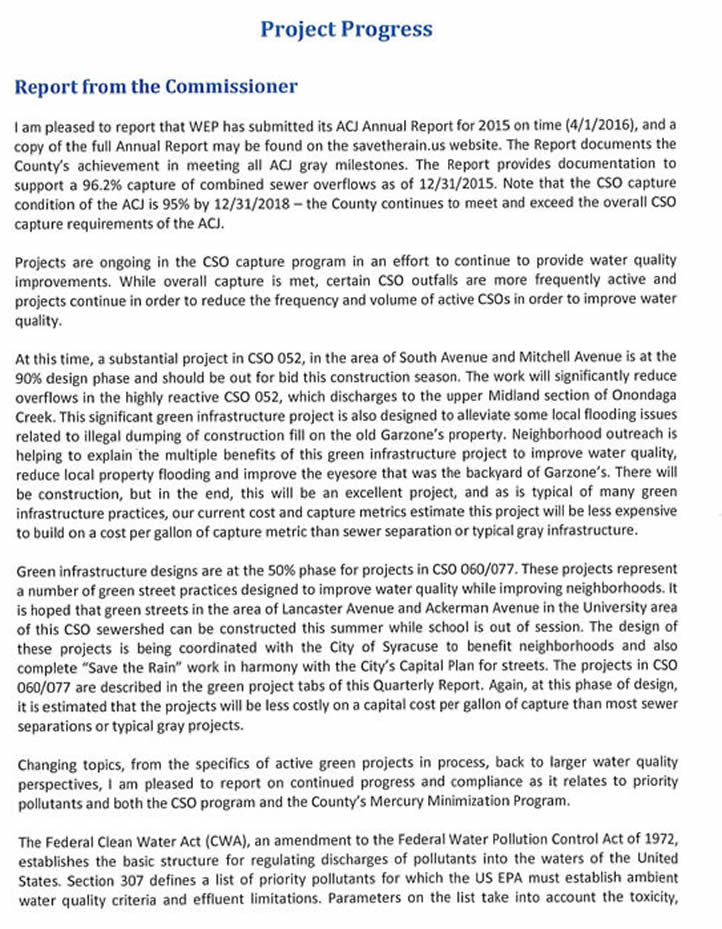
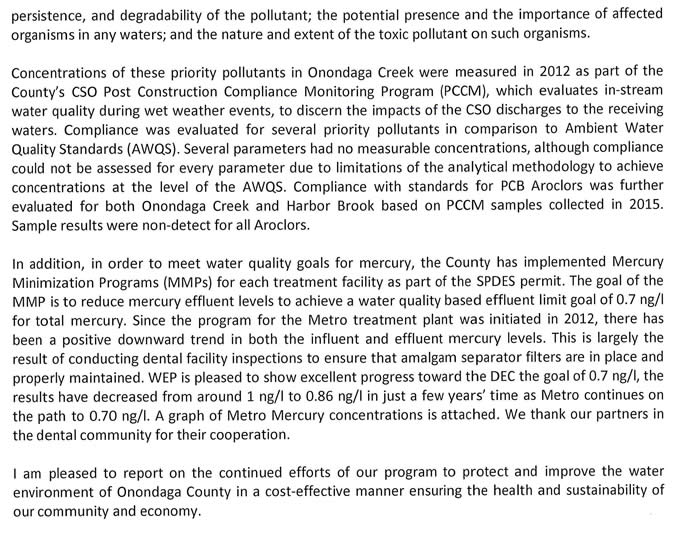

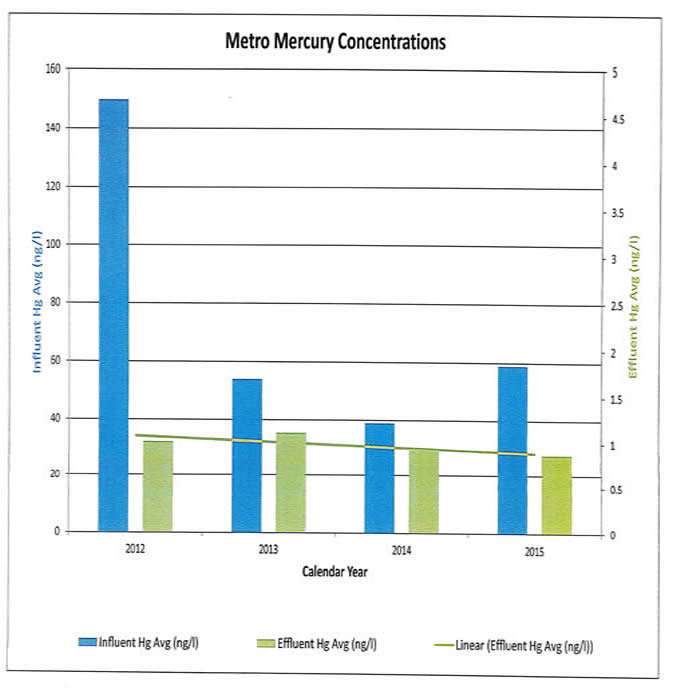
Mrs. Rapp asked why there was an increase in 2015. Mr. Rhoads said that these things happen when they start to talk about parts per trillion. They are trending in the right direction. Samplings like this wouldl have some noise - significant improvements since 2012.
-
Gray Projects Update: small Midland area project, Crehange St., 2016 construction of 3 catch basins, currently wet weather overflows at CSO 061, will disconnect and separate sewer at affordable rate due to close creek proximity
-
Green Projects Update:
-
Green Separation CSO 052 resolves local flooding issue primarily due to illegal dumping behind old Garzone’s; green infrastructure projects can solve a number of neighborhood issues, created backups, flooding and ponding areas, project will abate flooding and sewer overflows - capture water during wet weather events and gradually release back into the ground
-
Green Streets in CSO 060/077, red boxes show projects locations
-
State Street Green Corridor, received NYS Water Quality Improvement grant of $1.8M, adding water quality improvements to 3 sections of State St.
-
Green Improvement: public/private projects, committee made up of members from the comptroller’s office, CH2M Hill, the City and County Legislature that review private property owner’s proposals; projects built and maintained by property owners using some grants funds
-
Legislation & Media: much happening with and around Onondaga Lake; worldwide discussion of trash free waters, County “Connect the Drops” program in leadership position, Ms. Quinn presented the program to EPA Region 2 – liter most expensive trash, Connect the Drops campaign asks public to put liter in the right place, public education starting this month
-
Financial Update: includes all budgets and change orders
- Report purpose - to inform citizens, EPA and DEC
Dr. Chase said that she received several calls from citizens about the increase in trash received at OCRRA and asked if Mr. Rhoads knew where it was coming from. Mr. Rhoads said that more disposable income means more disposables. When he was at OCRRA, he had several long discussions about trash being the predictor of the local economic condition. Chair Plochocki encouraged Dr. Chase to reach out to the head of OCRRA, adding that he would be interested in the response.
The meeting adjourned 9:50 A.M.
Respectfully submitted,

KATHERINE M. FRENCH, Deputy Clerk
Onondaga County Legislature
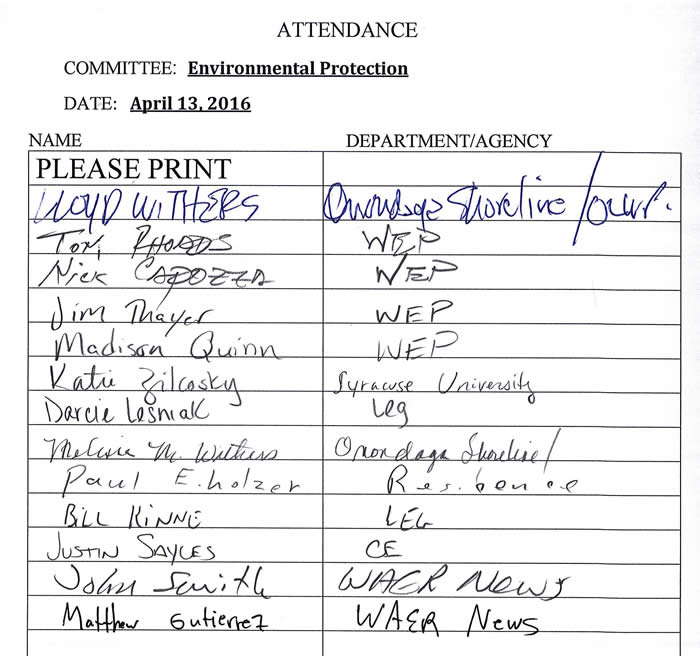
* * *
COUNTY FACILITIES COMMITTEE MINUTES - APRIL 13, 2016
JUDITH A. TASSONE, CHAIR
MEMBERS PRESENT: Mr. Shepard, Dr. Chase, Mrs. Rapp
MEMBERS ABSENT: Mr. Dougherty
ALSO ATTENDING: Mrs. Ervin; see attached list
Chair Tassone called the meeting to order at 10:38 A.M. A motion was made by Dr. Chase, seconded by Mr. Shepard, to waive the reading of the proceedings from the previous committee minutes. MOTION CARRIED. A motion was made by Dr. Chase, seconded by Mr. Shepard, to approve the minutes of the proceedings of the previous committee. MOTION CARRIED.
1. TRANSPORTATION: Brian Donnelly, Commissioner
a. A Resolution Authorizing the Reconstruction and Construction of Improvements to Various Bridges in and for the County of Onondaga, New York, at a Maximum Estimated Cost of $880,000, and Authorizing the Issuance of $880,000 Bonds of Said County to Pay Costs Thereof ($880,000)
Mr. Donnelly:
- Discussed items a and b simultaneously – annual bonds in alignment with 2016 Work Plan (On file with Clerk)
-
Work Plan demonstrates how funds will be spent, $1 million increase from last year, equates to an additional $1M from operating budget for capital projects – in line with 2016 CIP for operating cash and bonding
- Federal Aid Projects – paving, and miscellaneous drainage and facility guiderail
Dr. Chase asked if locals complete the work. Mr. Donnelly said that all work plan items were competitive bid. Local workforce conditions cannot be placed on federal monies. The jobs are not lucrative enough for outside vendors to bid on local jobs. Companies that have a presence in or very close to Onondaga County complete most paving work.
A motion was made by Dr. Chase, seconded by Mr. Shepard, to approve item 1a. Passed unanimously; MOTION CARRIED.
b. A Resolution Authorizing the Reconstruction and Construction of Improvements to Various Highways in and for the County of Onondaga, New York, at a Maximum Estimated Cost of $5,920,000, and Authorizing the Issuance of $5,920,000 Bonds of Said County to Pay Costs Thereof ($5,920,000)
- Both bonds included in Work Plan; separate bonds due to different periods of useful live
A motion was made by Mr. Shepard, seconded by Dr. Chase, to approve item 1b. Passed unanimously; MOTION CARRIED.
2. CNY ARTS: Stephen Butler, Executive Director
a. Amending the 2016 County Budget to Make Funds Available to CNY Arts for Distribution to Musical Associates of Central New York, Inc. ($75,000)
Mr. Butler:
- Requesting release of contingency funds
-
Symphoria doing well - 7 performances sold-out, adding 3 concerts next year, musicians pay will increase a minimum of 10% next year, keeping cash on hand to cover contingency
In answer to Mrs. Rapp, Mr. Butler said that about 25% of ticket sales were from out of town. A combination of day-trippers and overnight guests.
- Performing at the amphitheater this summer; hope to bring back annual fireworks concert
Mrs. Rapp said that this was everything they had hoped. Chair Tassone said that the backup provided with the agenda contained all the details (On file with the Clerk).
A motion was made by Mrs. Rapp, seconded by Dr. Chase, to approve item 2a. Passed unanimously; MOTION CARRIED.
3. ONONDAGA COMMUNITY COLLEGE: Dr. Crabill, President
a. Informational: OCC Liverpool
Dr. Crabill thanked the committee for their ongoing support and presented the following:
 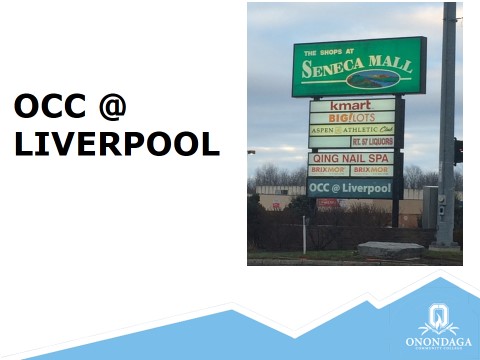
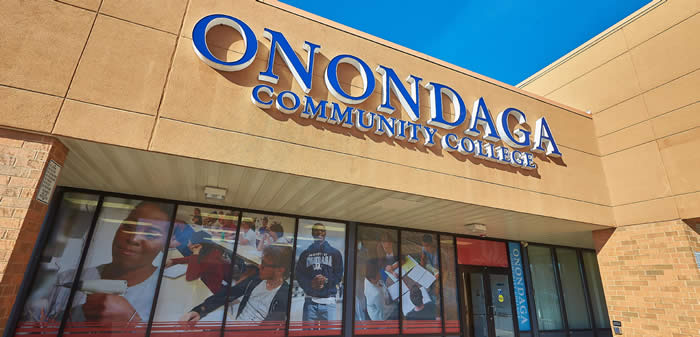
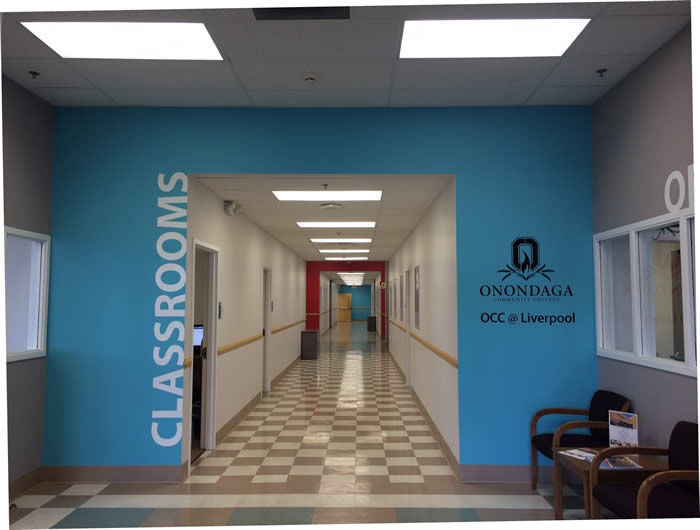 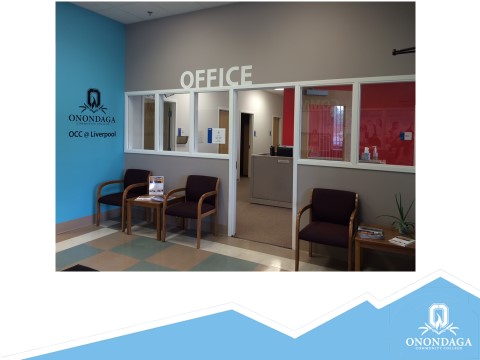
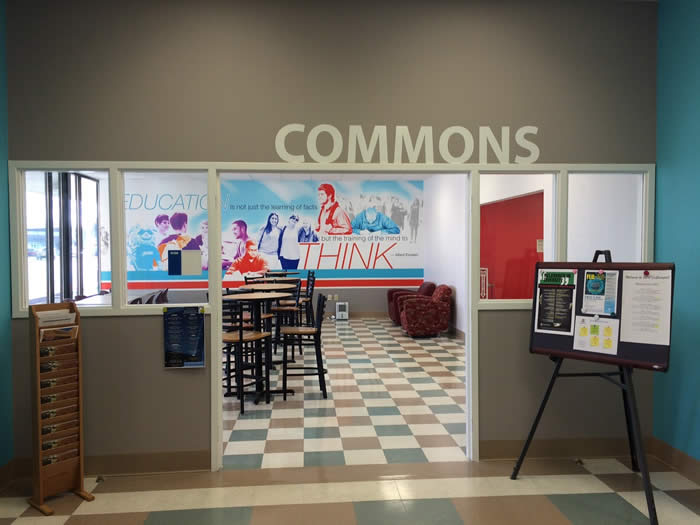
-
Hallway contains 6 classrooms and 30 station computer lab; small office provides space for rotating staff from main campus, site has 1.5 permanent staff, rotating staff allows for broad ranges of services without increased staff; small commons area for students to study, meet with tutors and eat lunch
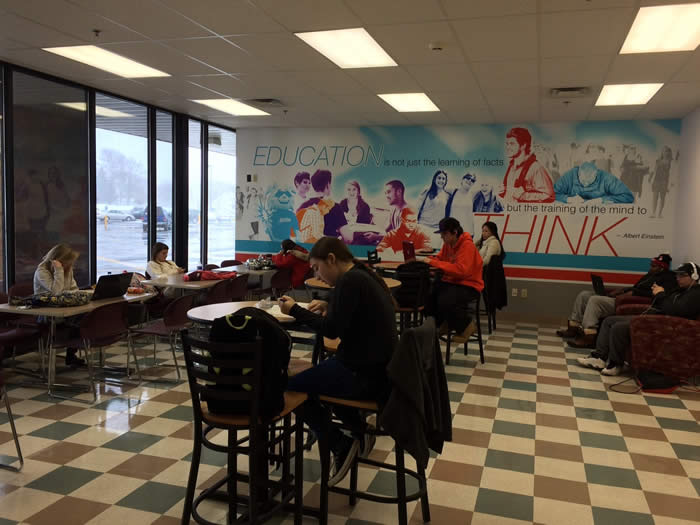 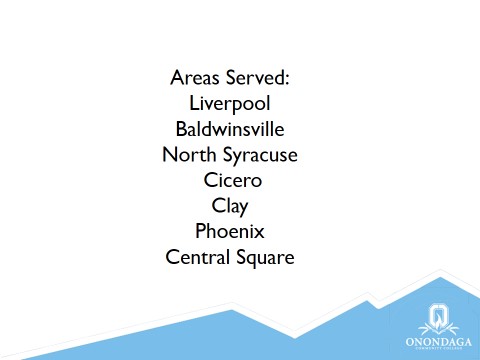
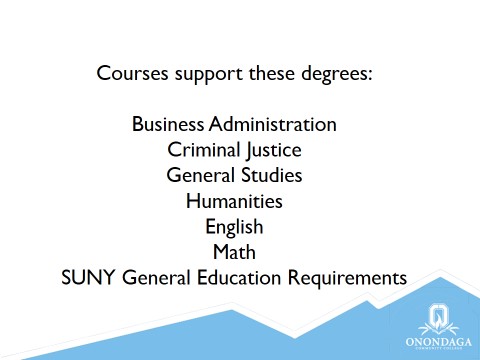
-
Blinds provide glare reduction without closing in building and help students feel part of OCC (See slide 3 above for outside view); site not a campus, offer just under 50% of degrees listed, plus wide-range of general education requirements, allows for serving broadest range of students without need for campus requirements, i.e. library
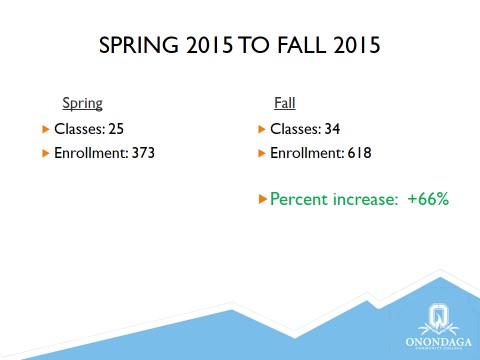 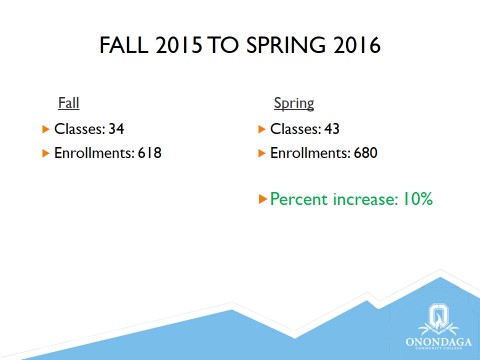
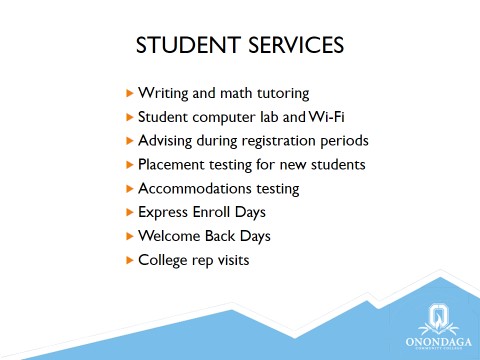
- Renovations produced increased enrollment - spring enrollment generally smaller; students enjoy location convenience
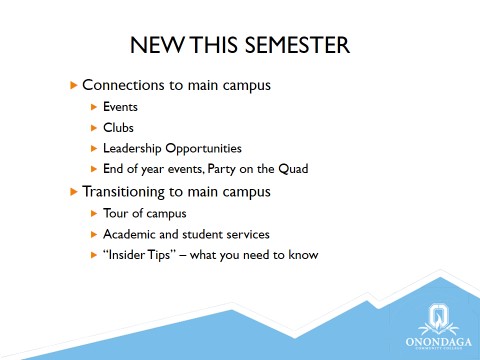 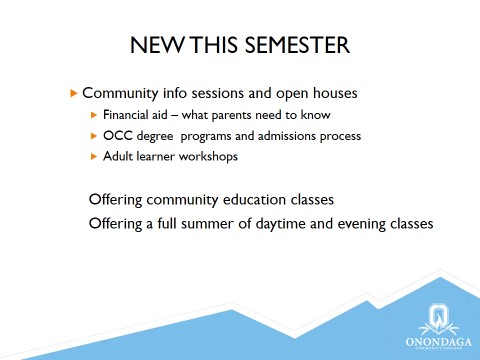

Mrs. Rapp asked if the first year was on site and the second year on campus. Dr. Crabill said that students are able to mix things in any way that works for their schedule. The schedule has been setup so that students may complete their entire first year at the Liverpool site, including electives, morning, noon or night. Mrs. Rapp said that this was great. Dr. Crabill said that the students really appreciate courses being available at all times.
-
Site also used to connect to northern suburb families, offer assistance on how to fill out financial aid forms to all – don’t have to be attending OCC, want people in the north to know that they are the community’s college and can help with their higher education needs; west quad renovations completed in 8 weeks - close of commencement through opening of fall semester, addressed concerns seen in last year’s tour
  
-
Rained 2 weeks straight last May, caused mud pool; number of grading issues and stair cases made it difficult for those with mobility issues to cross the quad, addressed those issues with purposeful ramps and intentional walkways
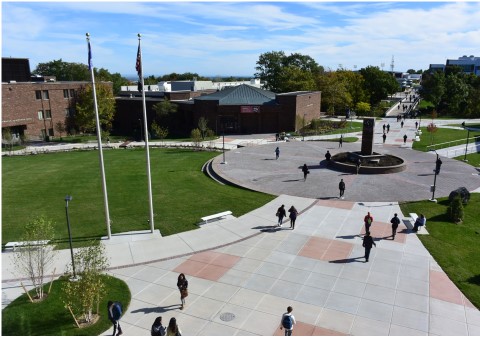 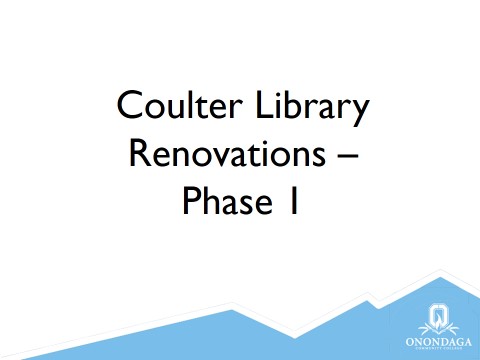
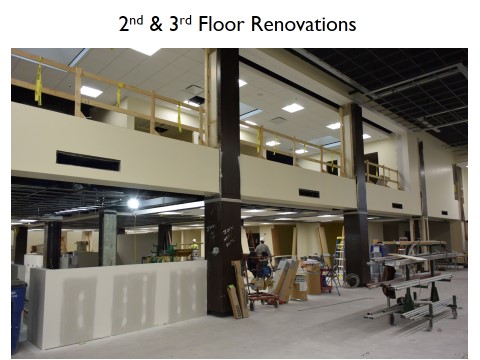
-
Gathering place for students, seating along clock tower base, fewer stormwater runoff issues, finding way much clearer; Library renovations broken into 3 phases – can’t close a college library or a year, Phase 1 near completion
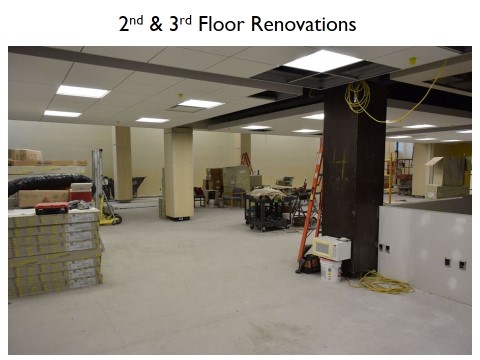 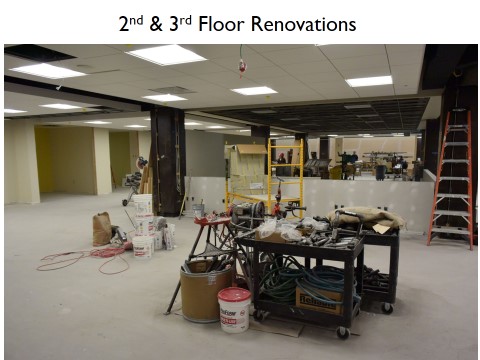
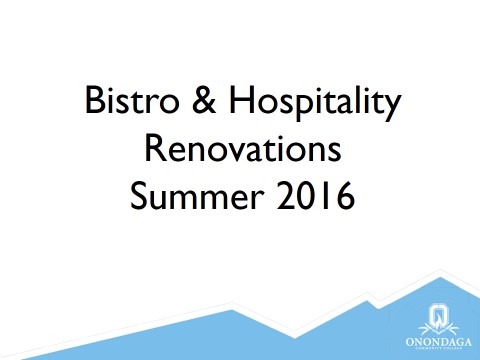
-
No structural changes - helped reduce price from original $34M guesstimate to $17M; Phase 2 front part of building where service offices are located, construction will occur over summer when demand for services are reduced, will have 8 weeks to complete; next fall will start 1st floor construction – challenge as building will only support stacks on the first floor, books will be moved around and librarians will be extra busy; achieved ability to lock off portions of the building and clear lines of sight to maximize use of staff and incorporated modern library technology
-
Awarded $4M SUNY 2020 grant for Labs to Jobs project, allows for rebuilding of hospitality program space on lower floors of Gordon, high demand program, Bistro to be relocated from top to lower floor – more work space for students with restaurant located next to kitchen, able to be part of preparation and serving, located next to new recital hall and available for public events, estimate January 2017 opening
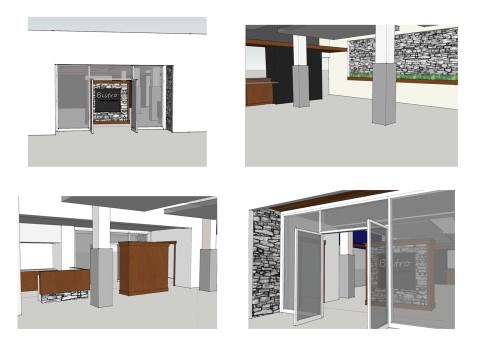 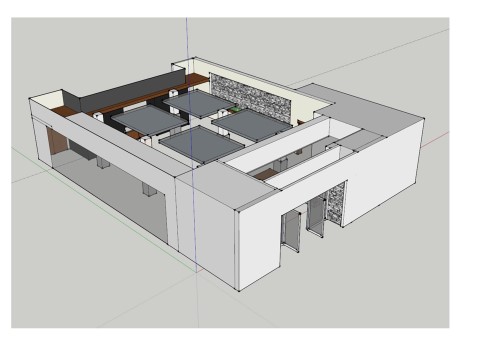
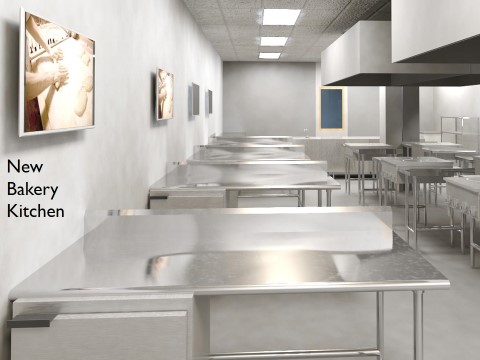
-
Adding bakery kitchen and retail space for student produced kitchen and bakery products – teaches students to prepare, package, price, retail and market; community based classes also, i.e. Mommy & Me Baking, Cooking for the Holidays, and various cuisines
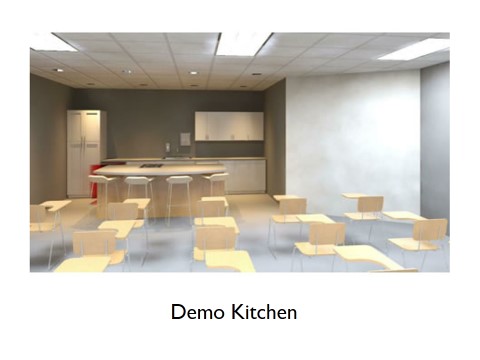 
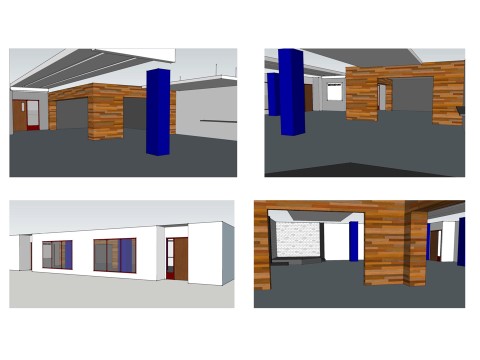
-
Demo kitchen with camera on chief, will project image onto screen, provides easing viewing of chief’s hands for all students desks from their desks, also used for nutrition and community based food preparation classes; moving student recreation to accommodate kitchen changes – grant paying for 1st purpose-built location for students to relax, process used to teach student government how to participate in process from design, funding and decision making, incorporating feedback from various groups to pull together a single space
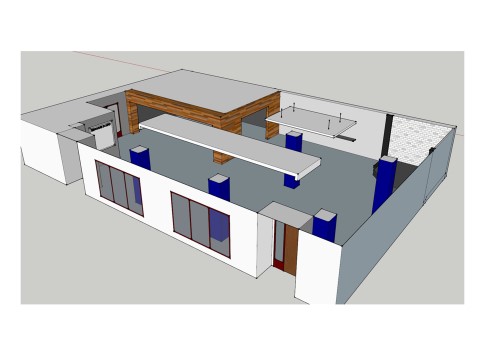
- Student designed rec room to accommodate various activities, will be run by the student government and located on 1st floor of Gordon
Mrs. Rapp asked if they made any progress in keeping Work Train Hospitality on the Northside. Dr. Crabill said that the bids came back yesterday and they hope to open this summer. There will be people learning entry-level jobs in the restaurant industry who likely would not qualify for a college program. At the same time, they will be pulling in people from the refugee community that want to open their own restaurant. They will get to run the restaurant, which will change cuisine about every 6 months, and work with the small business development center. In answer to Mrs. Rapp, Dr. Crabill said that the restaurant would be located at 435 North Salina Street. Mrs. Rapp said that it was a great location.
Dr. Crabill said that Work Train was a good partner, helping them connect with people. The first group of manufacturers just graduated through the Work Train Manufacturing collaboration; 14 of 16 students graduated and were all employed. They will follow students for two years - looking for job retention or leaving for higher wage. Eight participants had felony records that needed addressing before anyone would interview or employ them. It takes almost one-on-one assistance to address everything needed to become a good employee. All employer needs are built into the program, e.g. technical skills, arriving to work on time, appropriate dress and handling critical feedback. Students must hit all those marks before completing. Of the 14 graduates, 12 finished on time and two were kept longer to ensure they were at the necessary level. It is very exciting work and they are grateful for the federal seed money that got the program started. They hope to have those funds for another couple of years, which would allow the program to operate at full force and become self-sustaining.
Mrs. Rapp asked if there would be a program for health care. Dr. Crabill said that Health Train has various partnering entities; EOC and OCC are the training arms. Some partners have more specialty in the front end – connecting the agency, getting participants, helping with transportation or childcare issues. Each partner is doing their specialty and linking to the other partners for their expertise.
- Coming back to present budget; extremely busy with capital development - won’t be proposing any CIP for next year
Chair Tassone thanked Dr. Crabill and said that she would be back next month to present the budget.
4. FACILITIES MANAGEMENT: Duane Owens, Commissioner
a. Amending the 2016 County Budget to Accept Funds from Syracuse University Regarding Improvements to the Civic Strip ($325,000)
Mr. Owens:
In answer to Mrs. Rapp, Mr. Owens said that the estimated budget for the project was $200,000. There are no additional Connective Corridor projects planned at this time and he would return to request approval for any future projects.
Mrs. Rapp said that the CVB has been talking about installing kiosks for a while now. Dr. Chase questioned how well they would work in the winter. Mr. Owens said that the kiosks were built to withstand this type of weather; used in Charlotte, NC and other northeast cities. In response to Mrs. Rapp, Mr. Owens said that there was no shelter around them. Ms. Creatore said that they would be placed adjacent to sidewalk pathways so that they are outside of plow paths for snow removal. Mrs. Rapp said that the rendering all show them inside. Ms. Creatore said that there are inside kiosk locations also. Dr. Chase asked who would handle the programing. Ms. Creatore said that SU was working the WCNY to supply the content and confirmed that they would keep up with what was going on in the community. Dr. Chase asked if they would be specific to location. Ms. Creatore said that people could find information for all events at each kiosk. In addition, they are trying to incorporate an interactive game for the outside kiosks. Mrs. Rapp said that restaurants and hotels could buy space to display their specials and help support the kiosk. Mr. Owens said that one of the reasons for the outside kiosks was to help the students connect to downtown and to enhance the walking and biking experience. Dr. Chase said that it was interesting that there were no kiosks located in Armory Square.
In answer to Mrs. Rapp, Mr. Owens said that Facilities would be in charge of the process but would not be installing the kiosks. Chair Tassone said that they would not be using any County funds. Mrs. Rapp asked why SU was paying the County to oversee the project instead of doing it themselves. Mr. Owens said that grant stipulations did not allow them to procure the work themselves.
A motion was made by Mrs. Rapp, seconded by Dr. Chase, to approve this item. Passed unanimously; MOTION CARRIED.
The meeting adjourned at 11:13 A.M.
Respectfully submitted,

KATHERINE M. FRENCH, Deputy Clerk
Onondaga County Legislature
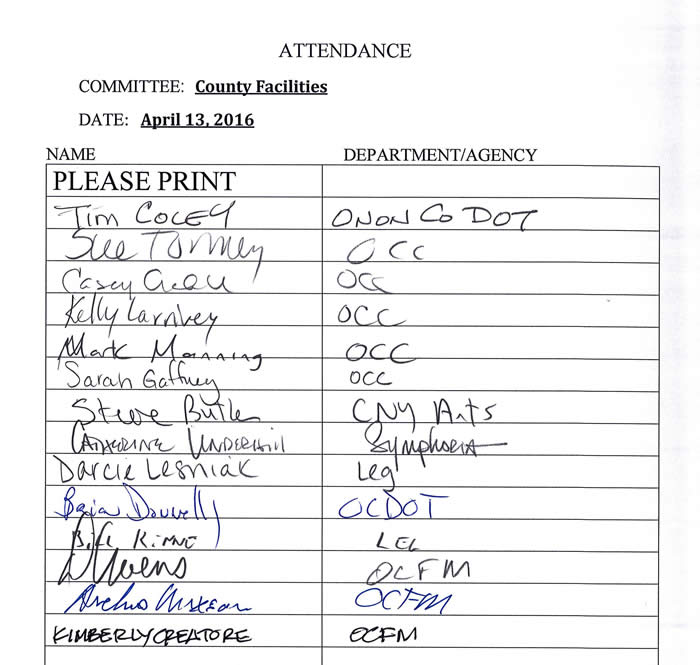
* * *
PUBLIC SAFETY COMMITTEE MINUTES – APRIL 13, 2016
BRIAN MAY, CHAIRMAN
MEMBERS PRESENT: Mr. Liedka, *Mr. Ryan, Mr. Holmquist
MEMBERS ABSENT: Mr. Dougherty
ALSO PRESENT: See attached list
Chairman May called the meeting to order at 12:01 p.m. A motion was made by Mr. Liedka, seconded by Mr. Holmquist to waive the reading and approve the minutes of the proceedings of the previous committee meeting; MOTION CARRIED.
Chairman May took the agenda items out of order.
2. EMERGENCY COMMUNICATIONS: William Bleyle, Commissioner
a. Amending the 2016 County Budget to Accept Funds from the New York State Department of Homeland Security and Emergency Services’ Public Safety Answering Point (PSAP) Grant Program, and Authorizing the County Executive to Enter into Contracts ($206,016)
- Accept $206,016 grant from NYS Dept. of Homeland Security and Emergency Services; PSAP Grant; sometimes receive annually; used to pay operational expense
- Bulk will support installing new phone system (currently working on); migrating to next generation phone system; moving from Verizon facility to E911 facility; any balance will be applied to normal phone bill
Mr. Bleyle responded to Chairman May that it is not a match; it is one hundred percent.
A motion was made by Mr. Liedka, seconded by Mr. Holmquist, to approve this item.
b. A Resolution Authorizing the Replacement of the HVAC System at the E911 Main Center in and for the County of Onondaga, New York, at a Maximum Estimated Cost of $1,788,852, and Authorizing the Issuance of $1,788,852 Bonds of Said County to Pay Costs Thereof ($1,788,852)
- Previously at committee on study done on HVAC system; 25 yrs old; cannot be repaired
- Funding from Leg to support engineer drawing up plan and replacement of system; engineering work 100% complete
- Est. cost of $1,788,852; seeking authorization for bonding and permission to execute contract w/vendor; replace HVAC
- Significantly under what was in Capital Improvement Plan (CIP); if bond approved, will replace system in fall 2016
A motion was made by Mr. Liedka to approve this item.
Chairman May asked if the $1.788 million includes the previously authorized engineering work. Mr. Bleyle responded that was already received. This is for the actual work. Chairman May asked if this has been to bid, or if it is going to bid, and how did they get to the number. Mr. Bleyle responded that in the CIP there was $350,000 allocated in 2015 for the engineering firm. County Facilities acquired services of IPD Engineering to look at everything and give specifications on what needs to be replaced. Mr. Bleyle received a report from IPD with an estimated cost including the construction, plumbing, electrical, equipment, etc. Mr. Bleyle said IPD believes this is a firm estimate (with contingency). Chairman May asked if the usual process is to send this to bid after the Legislature authorizes the bonding. Mr. Bleyle replied yes, and said he is relying on Facilities; who will work with the vendor.
Mr. Holmquist seconded the motion. Passed unanimously; MOTION CARRIED.
A vote was taken on item 2a.
Passed unanimously; MOTION CARRIED.
1. SHERIFF: Sheriff Eugene Conway
a. Transfer from Sheriff’s Office, Account 666500 Contingency, to Sheriff’s Office, Account 693000 Supplies and Materials, $175,374
Ms. Fricano:
- Resolution asking for half of money placed in contingency for supplies
- Early in year for forecast; took average of what was spent last year between March and August, then projected forward
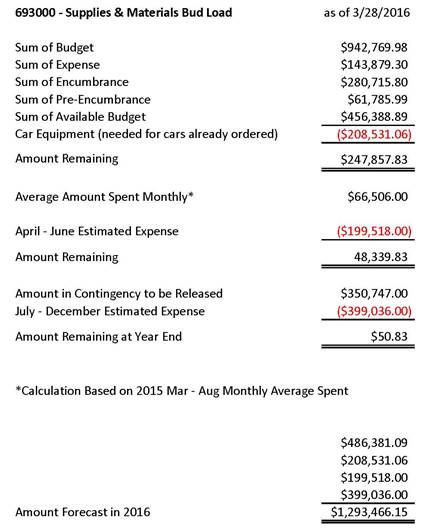
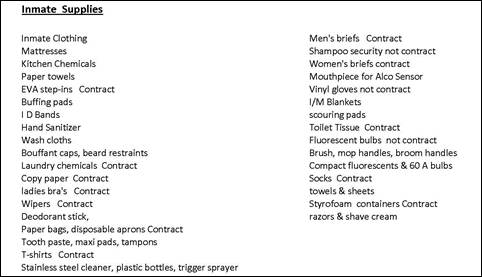
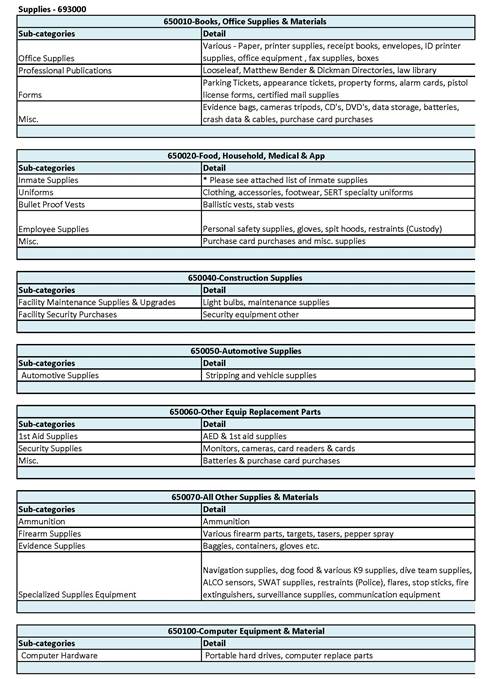
- Estimate in June will have $48,000 in supplies account; full contingency release by end of year, Sheriff’s will have $50
- Planning takes a while once money released, so now is the appropriate time to request release of half
- Chief Andrews will be back for second half, when there is a more solid projection
Chairman May thanked Ms. Fricano for the backup, and asked if this was part of the budget process last year. Ms. Fricano responded they had it last year. Chairman May stated this is not meant to be difficult, but to stay on top of things, and Sheriff’s has done an increasingly better job keeping the Legislature informed. It has been tremendously helpful. Chairman May asked if the initial backup included encumbered money. Ms. Fricano responded yes; the sum of the budget, expenses, pre-encumbrances and encumbrances are all included.
A motion was made by Mr. Liedka, seconded by Mr. Holmquist, to approve this item. Passed unanimously; MOTION CARRIED.
Sheriff Informational:
Sheriff Conway:
-
Safe Cell Project: headed up by Chief Gonzalez; began before end of last year
-
A safe cell minimizes capability of inmate to inflict self-harm and maximizes visibility
-
Normally cells set up with bunks 12” off floor; toilets and sinks set up in a way that an inmate could inflict self-harm
-
Sheriff worked with Facilities to convert 15 cells to safe cells; work has been completed; minimize opportunity for someone to inflict self-harm
-
Will cut down on constant watches; more of a frequent check; Deputies will have more visibility (more plexiglass); inmate less opportunity to construct method to harm themselves
-
New policy to Custody Deputies effective March 29th; speaks to inmates in need of mental health
-
Committee will hear more about it as Chief Gonzalez speaks about it; 15 cells converted, completed and in use
Mr. Liedka asked if the Sheriff knows who needs to be in these cells, if there is a protocol, or if it is random. Sheriff Conway responded:
-
Not random; Mental health professionals help classify if person should be on constant watch or not during screening before entering facility; inmate already in facility exhibits behavior, medical personnel will evaluate
-
Safe cell: bunk dropped to floor; different sink and toilet purchased; cannot eliminate, but minimizes inmate taking that course of action
-
Work done by Facilities; equipment purchased internally through commissary funds; work done while conducting 24/7 operation; credit Facilities for taking on 3 cells at a time while keeping work flow
Mr. Holmquist stated Sheriff’s has done a great job on the assigned cars, and asked if there is an end game on this. Sheriff Conway replied yes. The bulk of the take-home cars are the Detective vehicles, which are covered under contract. Other areas of reduction include Custody, Police and Civil. Sheriff Conway stated Chief Andrews chose not to use a take-home vehicle, and the Commander of the Civil unit does not have one either. Mr. Holmquist asked if anyone under contract has voluntarily stepped forward to give back a take-home vehicle. Sheriff Conway replied no, and said he has encountered resistance when trying to change the policy on take-home vehicles. The employees are aware of how the Sheriff feels about this (take-home vehicles a concern).
Mr. Holmquist asked about the status of the Jail Oversight Committee, and if they met. Chairman May responded they met earlier this month (or late last month). Sheriff Conway commented the first formal meeting of the committee was held a couple weeks ago. Chief Gonzalez sat in on the meeting, and the Under Sheriff has been meeting with Barrie Gewanter since January. Chairman May stated the Legislature will be getting the minutes from those meetings to review.
Sheriff Conway continued:
- Helicopter moving from Heliport; disappointed in speed of this not happening; continue looking to be at air base
- Doing this on a dime; biggest hiccup is fuel storage and fueling helicopter
- 174th been tremendous; bending over backwards; getting closer, but do not want to give date
- Purpose to get helicopter and other equipment out of heliport; building getting older; risk to damage to equipment
Mr. Liedka asked if the evidence is a similar situation. Sheriff Conway:
- Yes; asked 174th if there was hanger space for helicopter, response was yes
- Asked if 174th had room for other equipment (i.e. Bearcat, trailer); unfortunately not at this time
- Trying to come up with temporary site to house both evidence and equipment; maximize number of buildings
- Do not want to split time and energy going to two different places; committee will hear about this going forward
Sheriff Conway clarified for Chairman May that the helicopter is moving, and he would also like to move the other items in the heliport, because of the status of the building. Sheriff Conway stated there is no way to store the property evidence at the heliport. Only the helicopter will move there, which leaves the other equipment in the heliport and the property evidence to be addressed.
Chairman May said it sounds like Sheriffs is tightening up on the take-home cars. Sheriff Conway commented that there will be a point where contractually they cannot take vehicles away. Chairman May and Mr. Liedka agreed the job that has been done is very impressive.
Chairman May asked what the percentage of completion of the safe cell project is based on the Sheriff’s needs. Sheriff Conway responded the number fifteen was decided based on the pod it occurred in; as well as the resources and time it takes. It has taken almost six months to complete, and will now be evaluated on a cost basis and service to the inmates. The Sheriffs may come back for another ten or twelve, but will evaluate how this works first. Chairman May stated that the Legislature, and this committee in particular, has been behind any initiative to improve the jail situation, overcrowding and the expense to operate it. Chairman May urged Sheriff Conway to come back if they identify costs to keep this project moving (do not want this prohibited by annual budgets).
*Mr. Ryan arrived at the meeting.
Mr. Ryan discussed bringing forth an updated take-home vehicle policy for everyone that the Legislature can review. This would be a policy that the Legislature could adopt based on the study the Comptroller’s did some time ago. Mr. Ryan said possibly next month, and appreciates that the Sheriff has been working on it. Sheriff Conway reiterated that since taking office, the number of take-home vehicles has been reduced by ten. Probably by mid to late summer, there will be another three to five; which will bring the Sheriff’s Department down to the bare bones of what they are contractually obligated to provide. Mr. Ryan said there is that, and also some vehicles that should be taken home in the interest of public safety and running the department efficiently. Sheriff Conway stated the Sheriff’s has not increased any take-home cars since taking office. Chairman May commented that if the Legislature pursues a County-wide policy, then the results achieved by the Sheriff’s Office would provide some best practices. It would also be good to align the policy with the highest user of take-home vehicles. Mr. Ryan would like to sit down and talk with the Sheriff’s Department before bringing something forward.
The meeting was adjourned at 12:32 p.m.
Respectfully submitted,

JAMIE M. MCNAMARA, Assistant Clerk
Onondaga County Legislature
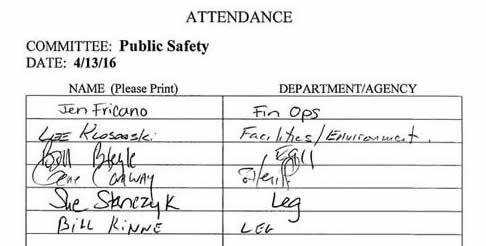
* * *
HEALTH COMMITTEE MINUTES - APRIL 14, 2016
DANNY J. LIEDKA, CHAIRMAN
MEMBERS PRESENT: Mr. Burtis, Mrs. Rapp, Mr. Holmquist, Ms. Williams
ALSO PRESENT: Chairman McMahon; see attached list
Chairman Liedka called the meeting to order at 9:32 a.m. A motion was made by Ms. Williams, seconded by Mr. Burtis to waive the reading of the minutes of the previous committee meeting. A motion was made by Mr. Burtis, seconded by Mrs. Rapp to approve the minutes of the proceedings of the previous committee meeting; MOTION CARRIED.
1. INFORMATIONAL: Crouse Hospital – Heroin Overdose/Injury Epidemic
Bob Allen, Vice President of Communications and Governmental Affairs
Monika Taylor, Director of Chemical Dependency Treatment Services
Mr. Allen:
-
Crouse in chemical dependency and substance abuse treatment business since 1962
-
Leader and only hospital based provider of substance abuse treatment in CNY
-
Seeing unparalleled interest in programs; good for business, but not society; programs include methadone maintenance
-
Ability to provide services on consistent basis hampered, because of cramped building; 100 years old
-
Hope to relocate services to larger facility in City; increase ability to bring more people in
-
Currently 330 people are on a waiting list for treatment; sadly people have died waiting to get into the program; trying to do everything to increase access; hopefully move to larger facility; no funding lined up, but aggressively pursuing
Ms. Taylor:
 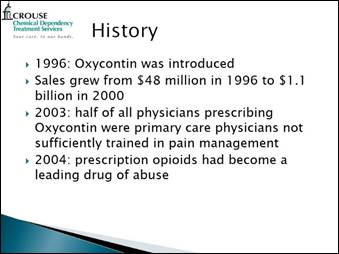
-
Prescription opioids originally meant for terminally ill patients; now shift to use medications for arthritis, back pain, chronic pain, etc.
-
By 2001, was adopted as Joint Commission standard; prescription opioids not only being promoted for all kinds of pain management, but also promoting the message to society that they should always be pain free
-
Physicians put in tough position then and now; on one hand they are being asked to help people to manage pain and also being rated on it; on the other hand, state agencies are saying people are getting addicted to meds and are dying
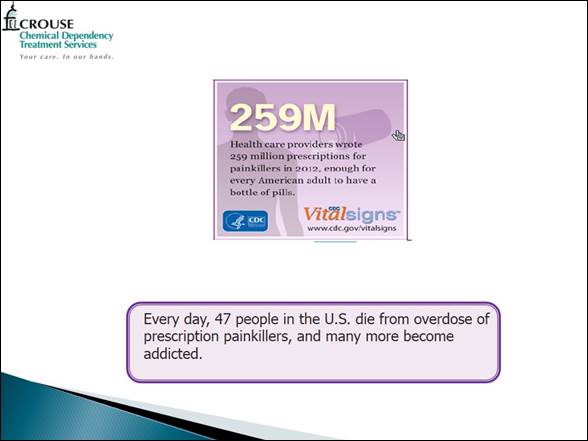
- US represents 5% of the world’s population, and consumes about 75% of all prescriptions
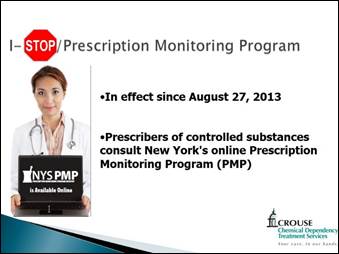 
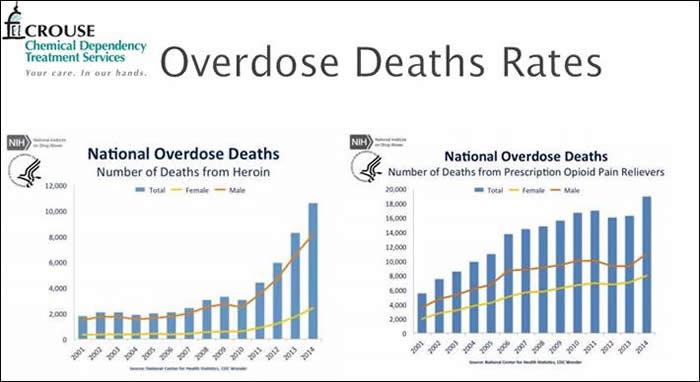
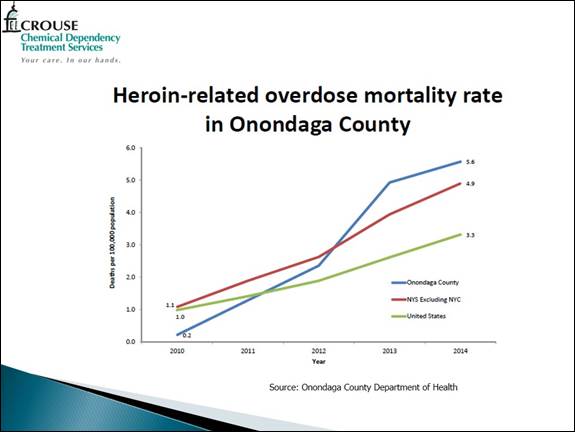
- Alarming stats; County higher than NYS (excluding NYC) and US
- Out of 100,000 there are 5.6 heroin deaths in Onondaga County; 4.9 NYS and 3.3 for US
Chairman Liedka asked if that is only Onondaga County, or if there are other counties feeding that number. Ms. Rooney responded that is only Onondaga County. Chairman Liedka asked why it is so much higher. Ms. Taylor can only speculate that there are more drugs entering the area through Canada. Also, Fentanyl is being mixed into Heroin, which tends to be deadlier. Ms. Taylor is not sure if it has always been tested. A lot of the overdose deaths are attributed to Fentanyl, which is approximately 50 times more potent than Heroin. A user will not know what they are buying, or what is mixed in. Ms. Rooney added that the numbers only go through 2014 (anticipate the number to be higher when including 2015).
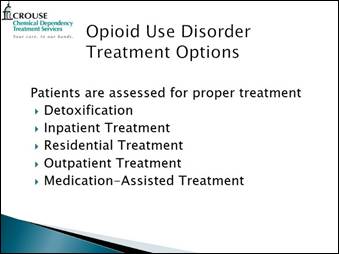 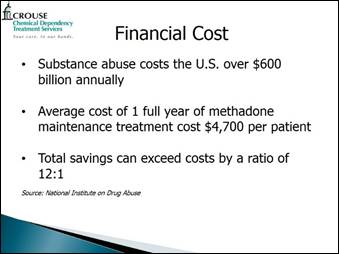
-
Not one treatment that fits all; look at each for best course of action
-
Detoxification: withdrawal; outpatient basis; may or may not need medications to continue to support recovery
-
Medication Assisted: Methadone - being provided at Crouse for over 40 years; Suboxone - available last 8 or 9 years that can be prescribed by primary care physicians, but not enough choose to do it
-
In-Patient treatment: good way to start and get away from use; be in an environment not exposed to drugs
-
Residential Treatment: Half-way houses; helpful to many after completing in-patient, and want to continue to seek service in out-patient
- Society keeps looking for solutions; making more treatment available should be one of them
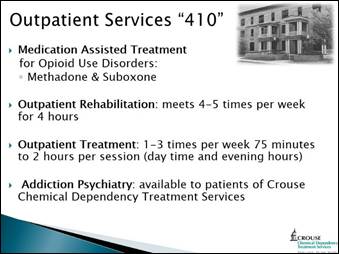 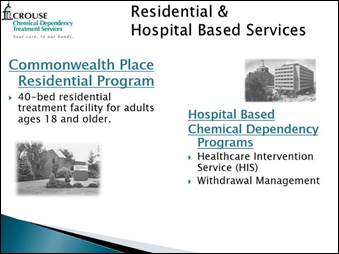
-
Methadone program has 655 patients; continue to admit; capacity is 800 patients; Suboxone has 75 patients
-
Other treatments – vocational services, recreational therapy, talk therapy
-
Most intense treatment is out-patient rehab; 4-5 times/week for 4 hours; learn life skills; prepare to step to lower level of care; lower level of care has specialty programs
-
“Women of Worth” – program in collaboration w/local treatment; services not reimbursable; grant funding; women receive treatment specific to their trauma (many horrific histories); provide employability services; women w/small infants can bring infant up to 6 months, and if more treatment necessary, patient will have help arranging child care
-
Other specialty groups: (1) older adults; most with medical conditions; (2) criminal justice group; (3) adolescent boys and girls as young as 12; (4) mental health disorder and substance abuse disorder groups; (5) recovery challenge, which includes individuals with brain injuries or developmental disabilities
-
Psychiatrist assists and helps with patients who present with mental health issues; unfortunately not enough psychiatrists, especially for Medicaid patients; beneficial to see patients and start on meds; treat same time as addiction
-
Commonwealth Place – started in 1989; gender specific; separate meal and counseling times
-
Hospital – dedicated to withdrawal management; counselors provide services; if someone’s in hospital for medical condition and attending notices a possible substance issue, they can request consult to make necessary referrals
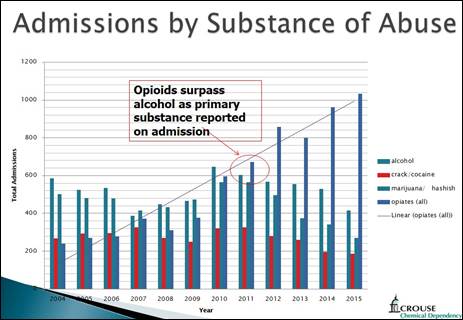
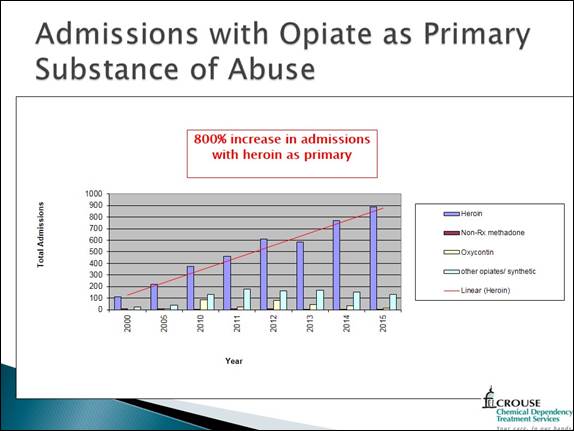
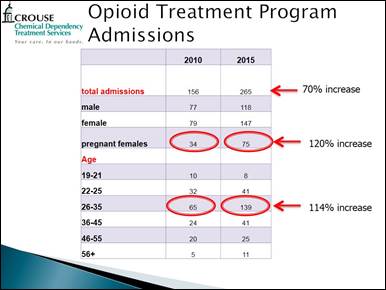
-
Pregnant opioid users – hospital sees more babies born with Neo-Natal Abstinence Syndrome; experiencing withdrawal after birth; babies have to be in NICU up to 30 days; big expense to hospital and taxing to staff
-
Baby with Neo-Natal Abstinence Syndrome has a cry that is heart wrenching; difficult to deal with for care taker
-
Other patients treated for other substances; 25% alcohol – big societal issue; April is Alcohol Awareness Month
Chairman McMahon:
-
Crippling situation with families’ have experience of this first hand; multifaceted for how painkillers prescribed; there are doctors out there that addicts go to - when that gets cut off, that’s when people go to the streets
-
Epidemic is not urban; kids prescribed are not inner city
-
Most troubling is when a person is ready to get help, and it is a tremendous challenge; waiting list not Crouse’s fault
-
As community a waiting list is unacceptable; going to lose those people
-
Can Crouse quantify a dollar figure of what it would take in this County to not have a waiting list?
-
Most people that struggle takes years to get help; sometimes it’s too late, or insurance issues get people kicked out
- Honest dialog of what it will cost to get people help; earmarks are nice, but not addressing; failing community
Ms. Taylor responded:
- Comprehensive approach; treatment crucial; someone ready does not want to be told to be on waiting list
- Offer other treatments, but most opioid users are looking for medication assisted treatment (not enough capacity)
- Those not looking for medication assisted treatment can call and come in today; same day access for treatment
Chairman McMahon stated collectively there needs to be better support outfits like Crouse, so people can get help. The numbers are staggering for the 26 year old generation. It is a hopeless situation for families. Chairman McMahon would like to ask what the right price tag is for the County. Mr. Allen replied:
- Multitude of answers; facility known as 410 cannot physically take any more patients
-
Current building is 32,000 sq. ft.; looking to get 52,000 - 54,000 sq. ft.; can treat 350 - 400 additional patients every year; would create access and immediate treatment; cannot do that now
- $17 mil project; no funding yet, but working on it; talking to City, County, State and Federal; process started and ongoing
Chairman McMahon suggested the idea of using drug seizure funds for treatment. Crouse is a tremendous resource that is meeting the challenge, but unfortunately not fast enough.
Ms. Rooney:
-
Dr. Gupta putting together more comprehensive plan; looking at prevention (do not want waiting list for members of community needing services); mobilized a Physicians Working Group to discuss this
-
Need more doctors that can prescribe medications to address addiction versus only prescribing opioids
-
Anticipate bringing plan over, because there will be dollars attached; prevention side is smallest expense
-
Need to get public communication out about what is going on; stop pipeline of treatment
-
Babies born with Neo-Natal Abstinence Syndrome puts pressure on Child and Family Services; often times leads to hotline calls; baby at risk; number of cases of children stabilizing, but intensity of cases are going through roof
Chairman Liedka said that marijuana is seen as “just weed”, but learned from Ms. Taylor that even marijuana (seen as harmless) is now being mixed with opioids. Ms. Taylor commented:
-
There are dealers mixing heroin with marijuana to get users hooked on heroin
-
i.e. user tries marijuana, but feels something wrong and starts to experience withdrawal without realizing; dealer then offers a pill (oxi or something) that will get the person hooked on opioids
-
As a community, crucial to do more with prevention and awareness
- How can society shift thinking away from being pain free? Need an educational approach
Chairman McMahon stated that dealers are buying Methanol off of the addicts to get it off the street.
Mr. Holmquist said it was an outstanding presentation, and agrees with education and prevention. Kids and adults do not realize that street drugs are not produced by Bristol Meyers Squibb, so there is no quality control (who knows what is in there). It could be a death sentence with one use. Chairman Liedka has talked with others including Dr. Gupta about what can be done to hit social media avenues regarding this (Facebook, Twitter, etc.). Social media is the one medium out there that hits every demographic, so this is something that is in the works. Mr. Allen commented that Crouse would like to partner with the Legislature and Dr. Gupta on this.
2. ADULT AND LONG TERM CARE: Ann Rooney, Deputy County Executive
a. Amending the 2016 County Budget to Make Funds Available to Support Crouse Hospital in its Provision of Chemical Dependency Treatment Services ($150,000)
- Crouse made compelling case; meager contribution of $150,000
- State of County - $100.000 to support 410; working with Legislature and Crouse’s needs - upped to $150,000
Chairman Liedka thanked the committee for their support. Chairman Liedka said if the County is able to invest this money, then he would like to ask that this be permanent in the budget moving forward until it is under control.
A motion was made by Ms. Williams to approve this item.
Mrs. Rapp asked where the funding is coming from, and Ms. Rooney answered fund balance. Mrs. Rapp asked if the money will be used specifically at 410 or throughout the program. Ms. Rooney replied it is for Crouse’s operational use for this effort.
All Health Committee members asked to be added as co-sponsors.
Mrs. Rapp seconded the motion. Passed unanimously; MOTION CARRIED.
b. Amending the 2016 County Budget to Accept Additional Funding from the Office of Alcohol and Substance Abuse Services and Authorizing the Execution of Agreements to Implement this Resolution ($275,000)
-
$125,000: Family Support Navigator - family in throws of crisis, need help navigating complex system with someone going through trauma of addiction
-
$150,000: shared with Onondaga, Cortland and Madison counties; Onondaga lead for staffing in ER’s; same idea, someone comes in who has overdosed, and staff will start support process; no local dollars
A motion was made by Mr. Holmquist, seconded by Mr. Burtis, to approve this item.
Mr. Holmquist asked if this is something to ask for annually, or is this an ongoing concern. Ms. Rooney replied it is hit or miss; sometimes it has to be applied for, and other times the State has funding to give. There is no set pattern, but the State is trying to be more responsive. Mr. Holmquist stated the intention is to apply for any monies available for 2017, and Ms. Rooney agreed.
Passed unanimously; MOTION CARRIED.
c. Authorizing the Execution of Agreements in Connection with Grant Funds from the New York State Department of Transportation Supporting Enhanced Mobility for Seniors and Individuals with Disabilities within Onondaga County, Including an Eligible Project within the Town of Elbridge
- Transportation program; Elbridge specifically identified as recipient, so there is an intermunicipal agreement
- Program provides transportation for adults who may be disabled; $0 local funding; county-wide
Mrs. Rapp asked why the Town of Elbridge is included. Ms. Rooney responded that it is a competitive process, and other municipalities could apply if they wanted to provide the service.
Ms. Williams asked if this is transportation to medical appointments. Ms. Rooney responded it could be medical, or it could be the Outbound Program (people can use so many times per month for shopping or appointments). It is all included, and there are no local dollars. The total is $894,000, and Onondaga County is receiving $447,000. Any agency applied must provide the match of $375.
A motion was made by Ms. Williams, seconded by Mr. Burtis, to approve this item. Passed unanimously; MOTION CARRIED.
d. Amending the 2016 County Budget to Accept Additional Funding from the Office of Mental Health and Authorizing the Execution of Agreements to Implement this Resolution ($792,800)
-
Almost $793,000; separate components all related to Mental Health; no local dollars; increase in moneys than what was anticipated in the budget
-
Peer Program for those with Mental Health issues going to ER; engage a peer who’s been through the process; people more receptive to those that have gone through similar situations
- Housing money included; $300,000 for Hutchings to try to reduce length of stay; $285,000 for Peer to Peer Veterans Pilot Program
Mrs. Rapp asked if the County is administering all the programs. Ms. Rooney answered some, and some are a pass through. The County, with the State, will administer the one for Hutchings, because they want to make sure the support programs in the community are ones that contribute to reducing the length of stay at Hutchings.
Ms. Rooney replied to Mr. Burtis that the veteran’s program is at Clearpath.
A motion was made by Mrs. Rapp, seconded by Ms. Williams, to approve this item. Passed unanimously; MOTION CARRIED.
The meeting was adjourned at 10:15 a.m.
Respectfully submitted,

JAMIE M. McNAMARA, Assistant Clerk
Onondaga County Legislature
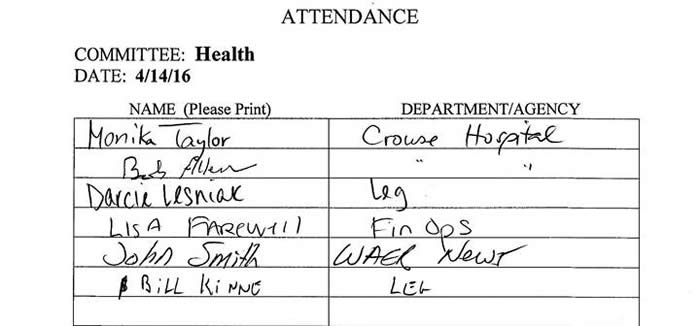
* * *
WAYS AND MEANS COMMITTEE MINUTES - April 22, 2016
David Knapp, Chairman
MEMBERS PRESENT: Mr. Jordan, Mr. May, Mr. Kilmartin, Mr. Shepard, Mrs. Ervin, *Ms. Williams
ALSO PRESENT: see attached list
A motion was made by Mr. Kilmartin, seconded by Mrs. Ervin, to waive the reading of the minutes of proceedings of the previous committee; MOTION CARRIED. A motion was made by Mrs. Ervin, seconded by Mr. Kilmartin, to approve the minutes of proceedings of the previous committee. MOTION CARRIED.
1. SHERIFF:
a. Transfer from Sheriff’s Office, Account 666500 Contingency, to Sheriff’s Office, Account 693000 Supplies and Materials, $175,374
2. EMERGENCY COMMUNICATIONS:
a. Amending the 2016 County Budget to Accept Funds from the New York State Department of Homeland Security and Emergency Services’ Public Safety Answering Point (PSAP) Grant Program, and Authorizing the County Executive to Enter into Contracts ($206,016)
b. A Resolution Authorizing the Replacement of the HVAC System at the E911 Main Center in and for the County of Onondaga, New York, at a Maximum Estimated Cost of $1,788,852, and Authorizing the Issuance of $1,788,852 Bonds of Said County to Pay Costs Thereof ($1,788,852)
3. ADULT AND LONG TERM CARE:
a. Amending the 2016 County Budget to Make Funds Available to Support Crouse Hospital in its Provision of Chemical Dependency Treatment Services ($150,000)
b. Amending the 2016 County Budget to Accept Additional Funding from the Office of Alcohol and Substance Abuse Services and Authorizing the Execution of Agreements to Implement this Resolution ($275,000)
c. Authorizing the Execution of Agreements in Connection with Grant Funds from the New York State Department of Transportation Supporting Enhanced Mobility for Seniors and Individuals with Disabilities within Onondaga County, Including an Eligible Project within the Town of Elbridge
d. Amending the 2016 County Budget to Accept Additional Funding from the Office of Mental Health and Authorizing the Execution of Agreements to Implement this Resolution ($792,800)
4. FACILITIES MANAGEMENT:
a. Amending the 2016 County Budget to Accept Funds from Syracuse University Regarding Improvements to the Civic Strip ($325,000)
A motion was made by Mr. May, seconded by Mr. Kilmartin, to approve the items on the consent agenda. AYES: 6; NOES: 0; ABSENT: 1 (Williams); MOTION CARRIED.
REGULAR AGENDA
1. ONONDAGA COMMUNITY COLLEGE:
a. Calling for a Public Hearing on the Tentative 2016-2017 Budget of the Onondaga Community College
A motion was made by Mr. Kilmartin, seconded by Mr. Shepard, to approve this item. AYES: 6; NOES: 0; ABSENT: 1 (Williams); MOTION CARRIED.
*Ms. Williams arrived at the meeting.
2. TRANSPORTATION: Brian Donnelly, Commissioner
a. A Resolution Authorizing the Reconstruction and Construction of Improvements to Various Bridges in and for the County of Onondaga, New York, at a Maximum Estimated Cost of $880,000, and Authorizing the Issuance of $880,000 Bonds of Said County to Pay Costs Thereof ($880,000)
Items 2a and 2b were discussed simultaneously.
- 2 separate bond issues - Bridge bond for $880,000; highway bond for $5,920,000
- 2016 highway work plan – two separate bonds as there are separate useful lives for bridges and for highways
- Approx. $1 million more than last year’s work plan – operating budget went from $1.5 million in cash capital for work plan to $2.5 million approved by the legislature
Mr. May referred to item B in the Highway Plan, Onondaga Lake Trail Extension, and asked where the work will end. Mr. Donnelly said they are progressing in design is the next portion of the loop the lake trail. It will be from where the lake currently terminates in the NYS Fairground parking lot, coming down the hill to the shoreline, ultimately going into the Honeywell Visitors Center - DEC is in the process of turning that into a boat launch. It will continue along Rt. 690 down to southwestern end of lake. A variety of options are being explored, but looking at a bridge that will cross CSX, and the trail ultimately coming out onto Hiawatha Blvd. In answer to Mr. May, Mr. Donnelly said it is before the creek walk with the idea, effectively the City had done a federal aid project on Hiawatha Blvd. at that end last year, that portion up to the creek walk would become an extension of the trail. Mr. May said that is is not the portion related to the resolution that Environmental Protection Committee passed last week that addresses Murphy’s Island. Mr. Donnelly agreed, adding that this phase is a portion of federal funding that they have for the trail. They will be back next year, as the other portion of federal funding is in next year’s federal fiscal year. In answer to Chairman Knapp, Mr. Donnelly said that this will get the trail over the railroad tracks. Chairman Knapp asked about Honeywell paving. Mr. Donnelly said that the county will come off the hill, down around the lake shore, down around the Visitors Center and then will pick it up at the end of the lake. The section that runs parallel to Rt. 690, will be handled by Honeywell and ultimately deeded to the county. Chairman Knapp asked if Honeywell will be doing any remediation, i.e. greens, grass, etc. Mr. Donnelly said that there will be visual aesthetics added in on that portion of the trail, but are yet to be determined.
Mr. Jordan referred to Guy Young Road, noting that the last time he was down it, it was in pretty bad condition. Mr. Donnelly said that they did do work on it last year, but it was a very thin overlay – just to stabilize it. It was part of last year’s work plan, and will be addressed this year.
Mr. Kilmartin asked what Mr. Donnelly sees going forward in the next year or two and asked if any substantial changes are foreseen. Mr. Donnelly said that he doesn’t from a plan perspective, noting that the federal aid varies year to year dependent on if in a design or construction cycle. Over the last few years, they have dramatically reduced the amount of bonding from where it had been at its peak in 2010-2011 period and were bonding for $11-$12 million/year. They have stayed consistent at $6.8 million over the last 3 years. In theory, they are trying to steadily decrease the amount of bond issue, and increase the amount of cash (pay as you go), within the operating budget. The size of the plan would stay the same; how it is funded could have potential changes.
Mr. Jordan said that the State budget significantly increased CHIPS funding and asked what the anticipated effect will be on future budgets. Mr. Donnelly said that the changes in the CHIPS money is always somewhat speculative. When they increased it from $4.7 million up to $5.6, the state said it was only for two years. It has stayed there; and hope it continues. There is some additional paving money in the state budget for the counties, cities, towns, and villages – Pave New York program, which is not represented in this work plan. The amount for Onondaga County is $1.2 million, but do not have any specific on the plan at this time – state has not put out any guidance as to how that funding is to be spent. As soon as they have that, he will come back to the legislature and ask for those funds to be appropriated. In answer to Mr. Jordan, Mr. Donnelly said that the Pave New York is being distributed based on the CHIPS formula. It is $100 million statewide, allocated the same way the CHIPS formula is for cities, counties, towns, and villages. There is another program, Bridge New York, but there aren’t any details on it yet – has been told anecdotally that will be a competitive program.
Mr. May said that he Pave New York money would add to the plan, not offset. Mr. Donnelly agreed – it would be additional state funding. Mr. May asked if it is work that could get done in the 2016 season. Mr. Donnelly confirmed that it is.
A motion was made by Mr. Kilmartin, seconded by Mrs. Ervin, to approve this item. AYES: 6 (Knapp, Jordan, May, Shepard, Kilmartin, Ervin); NOES: 0; ABSENT: 1 (Williams); MOTION CARRIED.
b. A Resolution Authorizing the Reconstruction and Construction of Improvements to Various Highways in and for the County of Onondaga, New York, at a Maximum Estimated Cost of $5,920,000, and Authorizing the Issuance of $5,920,000 Bonds of Said County to Pay Costs Thereof ($5,920,000)
A motion was made by Mr. Kilmartin, seconded by Ms. Williams, to approve this item. Passed unanimously; MOTION CARRIED.
3. CNY ARTS: Stephen Butler, Executive Director; Catherine Underhill, Managing Director - Symphoria
a. Amending the 2016 County Budget to Make Funds Available to CNY Arts for Distribution to Musical Associates of Central New York, Inc. ($75,000)
Mr. Butler:
- Selling out performances, adding concerts, increasing musicians salaries by about 10% for next season
- Attracting new, more diverse, audience base – 25% of their attendees coming from out of county
Ms. Underhill:
- Next year – keeping 5 pops concerts
- Sold out 7 concerts this year
- Adding performances of Holiday Pops, Star Wars
Mr. Shepard asked what the price tag is for 10% increase in salaries. Ms. Underhill said about $50,000/year. Musicians are operating at a compensation rate of about 30% under from where they were with SSO--have held off with reinvesting funding - focused on increasing marketing to expand the audience. Musicians had to wait for any adjustments in compensation; feel that it is an appropriate step to take now so they can continue to attract and retain the professional musicians. Mr. Butler said that there is a cost benefit analysis when musicians are kept employed full time and they are not jobbing in musicians -- more favorable in terms of economics. Ms. Underhill said that is true for most positions used regularly. Their salary year is the 37 weeks – they don’t get salary year round. She said that they are trying to move the needle on that so that a people contemplating coming to Syracuse can actually make a living by both teaching and performing -- it is not enough for them to make a living right now.
In answer to Mr. Jordan, Ms. Underhill said that many musicians teach year round, many are faculty members at S.U., LeMoyne, Hamilton. They try to piece together a living. To attract young musicians, coming out of music school, all with Master Degrees from places like Julliard and Curtis – want to be able to get them to come here.
Mr. May complimented Ms. Underhill -- the balance sheet balances, the profit/loss statement shows $110k to the good – it is great progress; the business is apparently being run well. He wants the county to continue the support this, but wants it done a little differently than how is it done. He will be voting against this, but would love to be able to support it, if a better way can be found to do so.
Chairman Knapp asked about the fireworks/concert on the 4th of July. Ms. Underhill said that they are working on a vocalist to accompany the orchestra. It will be at 8:00 p.m. at the Lakeview Amphitheater. They are working on collaborating with the Food Bank to encourage people to bring food in; trying to raise money for the fireworks; looking for a sponsor. The whole orchestra and the Syracuse Pops will be there; it will be a great community event and hope to draw people from afar. It will close out with with a magnificent fireworks display over the lake.
A motion was made by Mrs. Ervin, seconded by Mrs. Williams, to approve this item. AYES: 6 (Knapp, Jordan, Kilmartin, Shepard, Williams, Ervin); NOES: 1 (May). MOTION CARRIED.
4. COUNTY CLERK: Lisa Dell, County Clerk; Malcolm Merrill, Deputy County Clerk
a. A Resolution Authorizing Replacement of Software and Hardware at the County Clerk’s Office in and for the County of Onondaga, NY, at a Maximum Estimated Cost of $600,000, and Authorizing the Issuance of $600,000 Bonds of said County to Pay the Costs Thereof ($600,000)
Chairman Knapp said that there is a procedure in place concerning capital projects, wherein the first meeting is an informational, to hear with the goals and plans are. It gives legislators time to look at it and talk about it, then at the next meeting in can come back for an actual vote. Therefore, no vote will be taken today on this item.
Ms. Dell distributed the following:
INFORMATION SHEET FOR ONONDAGA COUNTY CLERK’S OFFICE
A NEW, COMPUTERIZED INTEGRATED RECORDS AND FINANCIAL MANAGEMENT SYSTEM
- The County Clerk’s Office is in need of replacing its aged, legacy County Clerk application. The application was written in-house and the documents are stored in a 10 year old obsolete content management system. Peripheral printers are supply limited and end of life. In fact for these printers we have been reduced to repeatedly checking EBay to purchase replacement parts, ribbons, etc. as there are none available from any other conventional source.
- This system is nearly out of space and the office is in need of new modern functionalities to reduce manual processing of records, to generate income and satisfy the daily, increasing demands of the public for easier access to our records. The current system repeatedly goes down and customers are forced to wait up to several minutes for their receipts.
- The replacement of the Legacy County Clerk Document Management System was included in the 2016 Capital Improvement Plan. The former County Clerk was working on obtaining information to prepare an RFP and the project was put on hold for the new County Clerk when the former resigned in October of 2015 for a new position in State government.
- Informal quotes had been received from vendors ranging from $372,800 to $600,000. An RFP was issued on March 31, 2016 for a new system with submission by April 28, 2016. The vendors are highly competitive and we feel that they will bid fairly to obtain our business.
- Of the sixty three (63) counties in New York State, forty eight (48) have records online available to public for a fee whether it is by an hourly rate and/or subscription and also have the capability of e-recording of land records. Of those sixty three (63) counties, fifty one (51) use an outside vendor for clerk software functions. Outside vendors will keep up with advancing technology and the efficiencies it offers.
- County Clerks I spoke with from across the state have said that there are no negatives aspects of having the capability of on-line records and the e-recording of records. They “boast” of the extra revenue generated as well as the reduction of storage of records. These are the functions that our customers and the public are asking my office to provide.
The following are some advantages of obtaining a new, outside vendor records and financial management system for the Onondaga County Clerk’s Office:
- 24/7 convenience to the public whether from inside our county or elsewhere, nationwide.
- Immediate openness and transparency of our public records
- Revenue Generator: The table below is an idea of the amount of revenue generated in other counties and the figures indicate that people will pay for this convenience. Counties with on-line search and print capability offer a variety of fees and rates across the board to consist of an access fee and a flat rate per page print, subscription rates for unlimited access plus per page print, a set subscription rate and or daily 1/2 hour or 24 hour viewing rate for downloads. Many options are available to customize our print model to satisfy the needs of our both our public and commercial customers.
COUNTY |
POPULATION |
APPROXIMATE ANNUAL REVENUE - ON-LINE DOCUMENT SEARCH |
Onondaga |
467,206 |
$293,711 2015 -in house copies only |
Albany |
304,204 |
$79,000 |
Duchess |
297,488 |
$120,000 to $144,000 |
Erie |
919,040 |
$260,000 - $280,000 |
Orange |
372,813 |
|
Rockland |
311,687 |
$252,000 |
Westchester |
949,113 |
$350,000 |
IT Operating Costs for the Clerk’s Office should be significantly reduced with an outside vendor software program. (2015 interdepartmental charge to our office was $2,675,657.49) After the mainframe is discontinued new costs should only include the use of County purchased hardware and equipment, internet access and support if hardware fails. The selected vendor will maintain, update and address any software issues. There will be an annual cost of maintenance with a new program. Vendor will provide advice and specifications for equipment. Cloud solution removes the need to upgrade/purchase servers, save money and increase speed.
Improved work flow efficiency, free up staff to perform other duties with foreseeable reduction in staffing levels through attrition with continued expansion of court e-filing and the introduction of e-recording. Note: Rockland County does 29% of land recordings in e-recording.
As more records are imaged and back-scanned, along with more people e-recording, paper storage will be reduced as well as the cost of storage in vendor and outside county facilities. We are over capacity now in our main office as well as our storage locations in the basement of the Court House.
Ms. Dell added that she has a 10 year spread sheet detailing the IT interdepartmental charges to the Co. Clerk’s office, if anyone would like to see it.
- Visited other county clerks to looking at their programs
- There are 3 primary vendors, and RFP’s were sent out to 6
- Counties boast of the income received from online public images
- e-filing – done now for county and supreme court cases; was selected to be in a PILOT for criminal e-filing
- e-filing reduces paper
- Pay interdepartmental (offsite at Molloy Rd & Marcellus) and outside vendor for storage – vaults are at full capacity
- Free up staff – foreseeable reduction in staffing through attrition – tentatively have a couple employees retiring this year – would like to keep the system in and see if those positions could be replace – salary/benefit savings
Mr. May said that he thinks all legislators have seen what the situation is and have maybe seen the archives. It is amazing it is all there in paper form; it is a problem/liability – obligated to keep the records in perpetuity.
Mr. May said that during the budget nearly every single department spoke about the interdepartmental charges. This is a way that we know interdepartmental charges can be reduced. Some of the savings may rival the cost of buying the software. This will generate revenue; get us to a return on investment quicker. Efficiencies gained for the office are to the good – also getting the investment to pay for itself much sooner. He recommended that this not be bonded for, but supports it.
;
Mrs. Ervin said that this is the way we should go for the public’s perspective. The cost is not an issue; it is the right thing to do.
Mr. Jordan said that he has talked about this for year – it has been a long time coming. Having 24/7 access is great. People spend an enormous amount of time coming down to get copies of deeds, etc.; to be able to do it on line will be a great improvement. Ms. Dell said that nearly every day she gets a call asking about how to get a copy of a deed; now there is way to put it on line, pay a fee. They pay for the convenience, but don’t have to pay to park or take two hours out of their day; will be a convenience for attorney’s who can obtain documents from their offices. Mr. Jordan referred to the tenant companies in the Clerk’s office -- they could work from their offices. Ms. Dell said it may save some money, as they have county has computers in their cubicles, but not all of the records aren’t images, so the tenants will still be there, paying the rent. Maybe eventually some may go.
Mr. Jordan said there the decreased demands on the staff, there may not be a need for anyone to man the front counters, as eventually everything will be imaged on line. Ms. Dell said that the walk-in was greatly reduced in the county clerk’s offices that she. In the RFP vendors were asked to evaluate the workflow and make it more efficient – looking down the line, there may be additional costs savings through attrition/retirement.
In answer to Mr. Jordan, Ms. Dell said that she would like to have this completed by December 1st. This will come back in May with a vote at the June session; it is an 18 week process for a vendor to get everything going and then go live.
Mr. Shepard asked if imaging is still being done going backwards, or just going forward. Mr. Merrill said that back scanning has been done going back to the 1950’s. Ms. Dell said that judgments, business certificates, etc. are things that aren’t out there, but can be looked at on their computers – nothing confidential. Mr. Shepard said that there are people that can’t wait to pay for this.
Mr. Kilmartin said that this is a great project; wonderful to see it move forward. There will be a tremendous amount of support from professionals and people in the industry and from the general public. It is a good opportunity to promote something positive, as this unfolds and moved forward, he suggested coordinated with the county executive’s office to get the information out. People will be very anxious to use it.
Chairman Knapp asked if investments are needed for hardware. Ms. Dell said that they will need to purchase scanners. Some vendors will quote a replacement of all hardware, but there are a couple of component pieces that they will need. Legacy printers need to be replaced, and they are band aiding them along. County Purchasing can buy scanners and printers cheaper than a vendor will give a price for. The RFP went out without the request for prices for hardware. Mr. Sexton added that all three of the vendors looked at have Cloud bases solutions.
Chairman Knapp referred to the procedure. Mr. Merrill said that there is currently too much paper handling in the office. If a deed comes across the county; he would touch it, it would go the the recording department and work off of the paper, then finally it would go to the scanning department, where it would be scanned and returned to the filer. All vendors indicate that the need to go to scanning sooner and drop off the paper handling. Chairman Knapp asked if all of the scanning that has been done will be transferrable to a new system. Mr. Sexton said that they would be; the only things that gives him concern are the documents with handwriting on them, which need to be cleansed, but everything else is transferrable. Ms. Dell said that all of the vendors have redaction software for that kind of issue. The deputies see it at the first level, and if they have to do something with it or send it back to the filer to redact, then they do. They double and triple check to make sure there isn’t anything out there (i.e. social security numbers). Mr. Fisher referenced a concern a few years ago with real property tax records being searchable and issue with law enforcement’s home addresses – want to be careful that certain images aren’t searchable.
Chairman Knapp asked if the goal is to go all the way back. Ms. Dell said that there is a rule that the abstract/title companies have to be able to search back 50 years. Mr. Jordan said that in this county it is 50 years; in other counties it is 45 years back from the date of purchase. Mr. Shepard asked if there is a limited use in going back much further. Mr. Jordan suggested going back a little further than that, as there are some situations wherein it is someone’s ownership for 50-60 years. Mr. Fisher said that Vital Statistics may be able to provide some guidance. Ms. Dell said that there are things that aren’t made available to the public, i.e. naturalizations, but they can be microfilmed and then they can get rid of the paper. It can then be pulled up and printed vs. running out to Marcellus or Molloy Road--it would be more efficient.
Mr. Jordan said that there are situations, like a family farm, were the property changes from one hand to another, but the abstract is never updated. Unfortunately, you may have to go back quite a way. Ms. Dell said that her goal is that every piece of paper is imaged -- will start with the most requested records first.
Chairman Knapp asked if the hard copies of deeds will be kept. Mr. Merrill said that the original is returned to the filer. A hard copy will not be kept, just a digital image. Chairman Knapp asked if there are multiple safeguards in place to protect that data. Ms. Dell said that some of the vendors have tier levels – servers in a building that get fueled right away; have generators if there is a catastrophe, etc. Mr. Sexton said that they have backups’ and we keep an electronic copy as a safeguard.
5. INFORMATION TECHNOLOGY: Kevin Sexton, Chief Information Officer
a. Transfer from Information Technology, Acct. 666500 Contingency, to Information Technology Acct. 694080 Professional Services, $225,000
- Completed 1st quarter of budget forecast
- Most accounts are on target, but professional services is showing a deficit
- Great amount of money earmarked for continuing migration of applications off the mainframe
- 5 – 6 applications require consultants expertise: County Clerk; exam system processing, Bd. of Elections applications, interdepartmental billing, law enforcement, taxes
Chairman Knapp asked of the applications mentioned were all still on the mainframe; Mr. Sexton said that they are. Chairman Knapp asked if there are any others still on the mainframe. Mr. Sexton said that there are a few others: check producing applications: Trust Unit & Probation Restitution; payroll will hopefully move off later this year (PeopleSoft HCM), CHAIRS 2 – slated to go March 9th – have been developing it for 5 years; and a couple smaller ones also.
Chairman Knapp said that assuming the county clerk software request is successful, we wouldn’t be moving over what they have now – would be implementing the new program. Mr. Sexton agreed, but said they would need to be involved with the conversion process and transferring all of the electronic images.
Mr. May said that these drive interdepartmentals substantially and cost the taxpayers a lot of money. He asked if CHAIRS 2 is used all across the county by all law enforcement agencies, and asked if they pay the county for access to it. Mr. Sexton said it is used all across the county and do no pay the county for the services, other than the Sheriff’s Dept., which gets an interdepartmental bill for the time IT spends on it. Mr. May asked if there is an incremental cost to the county to provide it to the other agencies. Mr. Sexton said that there isn’t. It can be provided without incurring any more cost in support or maintenance.
A motion was made by Mrs. Ervin, seconded by Mr. May to approve this item. Passed unanimously; MOTION CARRIED.
Chairman Knapp said that there was money in the Connect New York Grant, $500 million, to help rural broadband. Unfortunately, Onondaga County is not eligible to apply for any of the grants in round one. The claim is that in the few areas Onondaga County has, Time Warner is supposed to fill in the blanks. Mr. Sexton said that the merger with Charter Communications is causing the holdup, which has not yet been approved by NYS regarding the stipulations to provide high speed broadband at a low cost. It is one of the blocking areas for the County, as Time Warner has an interest in some of the areas in the county. Chairman Knapp said that supposedly, Onondaga County will be eligible in Phase 2. It is discouraging because Time Warner won’t do anything in some of the rural areas – hopefully they will in the city.
Mr. Sexton said that an internet survey is available in draft to poll county property owners and he wants feedback on it. FCC data is skewed in showing that some of the territories are represented with high speed internet, when in fact they are not. Chairman Knapp said that a few years ago hard copies of the survey were taken to field days, clerk’s offices, libraries, etc. to get the word out.
6. MISC.:
a. A Local Law Authorizing the Sale of County Property Located off of Howlett Hill Road, Town of Marcellus (Sponsored by Mr. Plochocki)
Chairman Knapp:
- Trolley line used to run from Marcellus to Syracuse – abandoned a long time ago
- County assumed ownership of abandoned property – narrow strip through Tuscarora Golf Course
- Several property owners have approached county about getting a strip of land and it has been transferred to them
- County can’t use the property for any purpose, and really is a liability to the county at this point
Mr. Jordan said that the house was built over the property line - about 25’ over the boundary line; asked if this this sale is just the area that the deck is on. Chairman Knapp said that he believes it is - a very small strip.
A motion was made by Mr. Kilmartin, seconded by Mrs. Ervin, to approve this item. Passed unanimously; MOTION CARRIED.
7. PURCHASE:
a. Revenue Contract Report - Sean Carroll, Director
Mr. Carroll distributed the following:
TO: David Knapp, Chairman, Ways and Means
Committee Members, Ways and Means
FROM: Sean Carroll, Director
DATE: April 22, 2016
SUBJECT: Reporting Requirements under 2010-241 and 2010-242, Revenue Contracts
Revenue Contract updates
Facilities Parking Lot Management – still being evaluated. Vendors proposed a variety of management models and Purchasing is helping to determine under which scenarios for parking the concessions model is better than the management model and vice versa.
Carnegie Library Repurposing – This RFP was released April 5th and proposals are due April 25th. A copy of the proposal was transmitted to the Legislature through the Chairman and the RFP was distributed to 31 developers and interested parties.
Real Property Auction Services – to be solicited week of April 25th.
Mr. Carroll:
- Carnegie RFP – distributed to 31 developers and interested parties
Chairman Knapp asked if anything has come in on it yet; Mr. Carroll said that he didn’t think so – most proposal come in the day they are due.
- Facilities Parking Lot Management (Trolley Lot)
- have 5 proposals; looked at different models – concession and management
- some parking spots occupied now – looked at potential reviews
- looking at potential costs and risks
In answer to Mr. Jordan, Mr. Carroll said that the Facilities Dept. is managing about 130 monthly permits; there are about 402 total spots. Mr. Jordan said there may be a need/demand in the future with Upstate going into the Galleries. Arrangements were made for employees to initially park for free in Harrison garage. Over time, they will have to start paying for their own parking. Mr. Carroll said that there are opportunities to fill those spots. If there will be guaranteed tenants that is great, but if not guaranteed, then they are looking at financial upsides and downsides.
Mr. Fisher said that as the landlord, the county is in the business of getting parking for Upstate. Currently are in negotiations with owners of the Sibley’s garage to get approximately 83 parking spaces at market rate for Upstate. Also, talking to several vendors for parking spaces in garages for Upstate’s need. Sixteen handicapped space also have to be provided under the lease – at least 4 will come from Galleries. Regarding the Trolley lot, there is a significant downtown development where they may be looking for a couple of hundred parking spaces at a group rate and are negotiating that now. There may be a request to approve long-term leases – may have parking lot spaces leased in bulk, may lease parking spaces from landlords to turn around and lease them to Upstate. Since there are already 130 in the Trolley Lot and there are 400 spaces, it might be a factor to sell 100 or 200 at a time with a discount.
Mr. Jordan asked about the county, as a landlord, providing those spaces. Mr. Fisher said that they are working on an agreement with the Hotel. The Marriott Hotel Syracuse needs parking spaces for valet parking at night. The county is working on a sharing agreement where Upstate would use parking spaces during the day and the hotel folks would use the parking spaces at night. The parking garage owner would get market rate, county might get them for $35, the hotel might get them for $40, and then Upstate gets reasonable parking for several hundred of their employees and subsidize other parking. Mr. Fisher said that he is having a conversation with Chairman McMahon, and there may be one local law on the desks later today.
Mr. May referred to the Carnegie RFP and asked what determined the timeline for the RFP process; is it an industry standard. Mr. Carroll said that it is typically anywhere between 3 -5 weeks on the street, unless it is something like designing a piece of software with 900 pages of technical details. For Carnegie the county provided the most recent drawings, appraisals, and any information that was out there. In this type of situation, usually vendors come to the table with a fair amount of information – that timeline is pretty standard. Mr. May asked if the timeline within the process is standard; Mr. Carroll said that it is. He said that that they can’t open the bid/RFP without all vendors given equal and adequate notice of any changes. They work backwards from the opening date--making sure there is an opportunity for questions and for an addendum to go out; that the addendum has enough distance between it and the opening for everyone to have equal/ample chance to participate; that there was enough time in advance of that to be an adequate development for questions. If an RFP is put out for too long, people forget about it; if it is out for too short, then there is a complaint that there wasn’t enough time to get the information together. Mr. May said it is an RFP, because that is what needs to be done, but effectively we are trying to find out if people are interested in using the building. Mr. Carroll said that they cast the widest net that they could – asked if anyone wants to lease the whole or part of the building or buy the building. This gives the idea of “”what would you do with it and not leave it empty for the next 15 years” – questions like that were asked (to developers/interested parties).
Mr. May asked how will the legislature be informed of the process. Mr. Carroll said that he reports every month.
Chairman Knapp asked if he will be able to share the results, even preliminary, next month at Ways & Means. Mr. Carroll said that he expects to, depending on the number of responses.
Chairman Knapp said that parking is an issue there. Mr. Carroll said that they asked questions like: what do you see as year 1, year 5 plan; how will you handle the volume; how many people are your talking about bringing here, etc.
Mr. Kilmartin asked how many parking spaces are there; Mr. Carroll did not know; Chairman Knapp said that he thinks it is 29. Mr. Carroll said that it is less proportionately than what you would think it would be for the building. Mr. Jordan said that is typical for downtown, and referenced One Lincoln Center.
Mr. Jordan asked if the RFP is published or just sent to vendors that you think might be interested, with that being the limited exposure of the RFP process. Mr. Carroll said they typically develop a list of interested parties and send it out to them. In this case it was anyone that did a real estate development downtown, particularly those that had local offices, those that had expressed interest in the building already, and a couple of brokers.
Chairman Knapp asked if it is available on the Purchasing website and available to those not on the specific list. Mr. Carroll said that it not. If not on the list, they can call the office and get a copy. Mr. Jordan said that absent that list, people that are potential purchase or renters, are not going to have any idea that the property is even available. It seems the net is cast very large; it is being cast to those that have either done business with the county before or shown interest in this particular property. Mr. Carroll said that it is not just “done business with the county, but rather done business in the county.” Because they had 31, they felt that was an opportunity for someone locally to participate.
Chairman Knapp said that if putting out an RFP for pencils, how do we get it out there. Mr. Carroll said that a public bid is required by law to be publicly advertised. It is done in the Post Standard. When buying a service, or something with an RFP, the requirement is to develop a list of vendors that are eligible to participate and then send it out. Typically, they don’t advertise them, unless there is no ability to develop a vendor list. One reason not to advertise it, is that he doesn’t want people from, i.e. North Carolina, if they can get people locally. If they can get businesses to participate locally, and keep that money here, then they want to encourage that.
Mr. Jordan said that in this situation, we are looking to maximize what we may be able to get for the property. To get the best deal we can, you want to cast the net as wide as possible to incorporate as many potential purchasers or people that may be interested in developing the property. Certainly the preference would be for a local company. He referenced clients who are investors n NYC, where property is $1,000/sq. ft. For them to spend $1 million, it is a drop in the bucket. Some other areas of the country may be much greater resources and there may be more of an attraction to purchase property here, than a local company that may be willing or able to do. To limit the list to 31 people seems like casting the net awfully small. Chairman Knapp said that we’ll see what comes in and can always do another one, dependent on what comes back.
Chairman Knapp said that he has given a lot of thought to payroll inching up, concerned with sales tax numbers, thinks this year will start to get difficult as we move along. He thinks everything is on the table. Looking at the payroll situation – in court trying to decide who is responsible for what. It doesn’t give a good feeling that we have a good system, or efficient system. He asked the Mr. Morgan, CFO, to put together a report: what is payroll costing right now, including the PeopleSoft situation. He hopes to have it back in the next few months, before the budget process starts, to see if it something that in next year’s budget we should be contracting out for. “Under the current scenario, I don’t get a good feeling that the left hand and the right hand really know.” It is working, but doesn’t think it is working very efficiently. It is something that we should get some information on, see what we have, and see if it something that would make sense.
Mr. May said that if that is going to be done, then the timeline to the finish line with PeopleSoft should be looked at. It is a huge unknown, and recommends that it is factored it. Chairman Knapp agreed.
The meeting was adjourned at 10:17 a.m.
Respectfully submitted,

DEBORAH L. MATURO, Clerk
Onondaga County Legislature
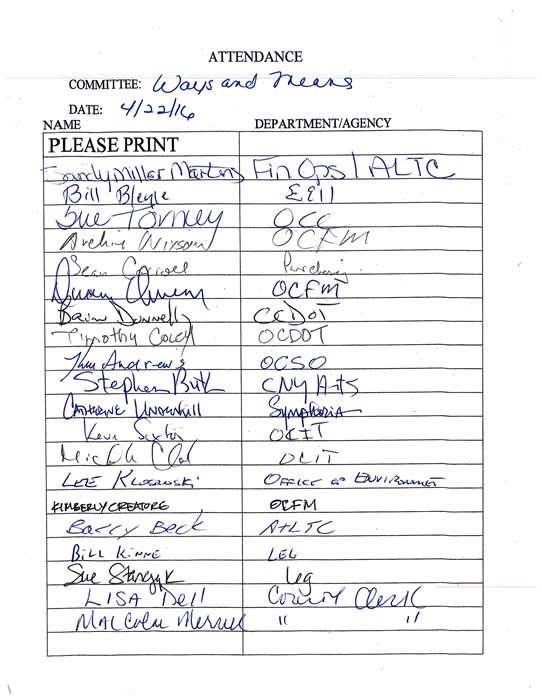
|














































































